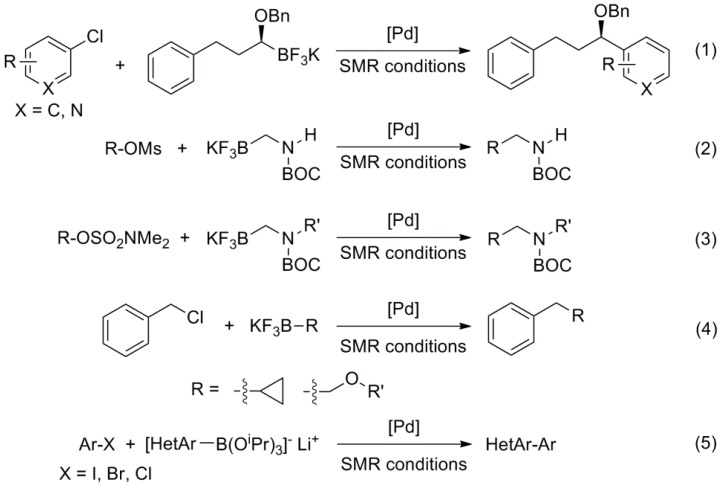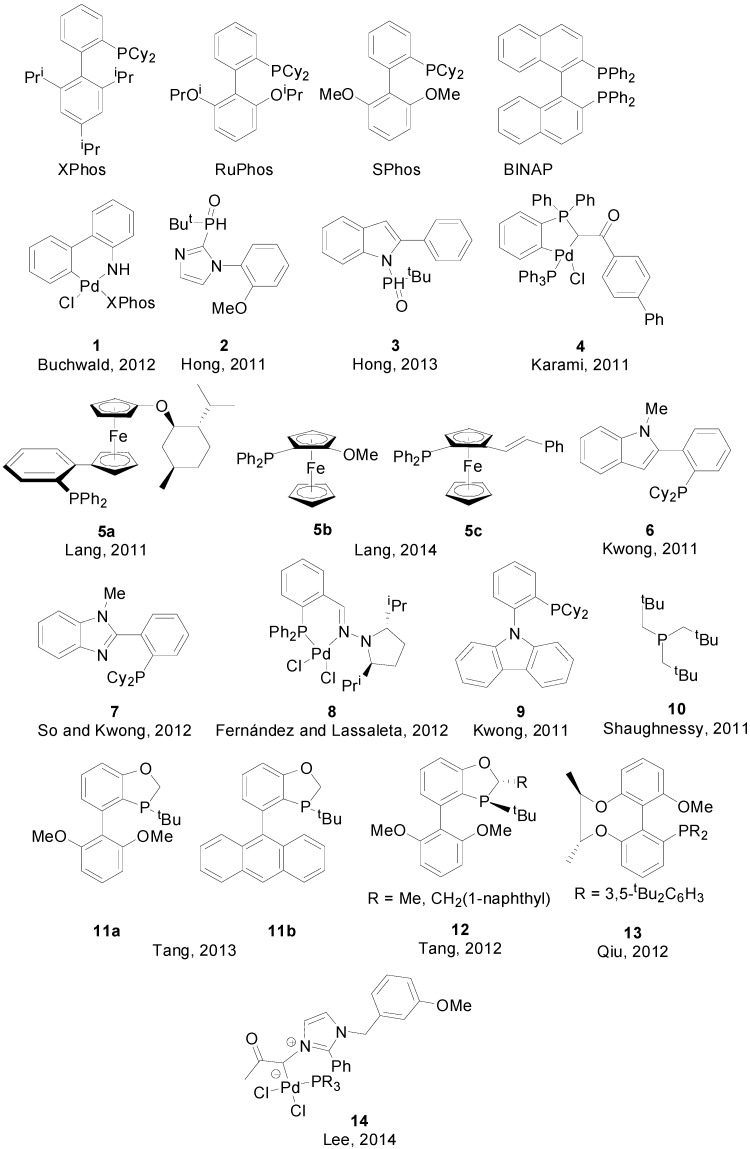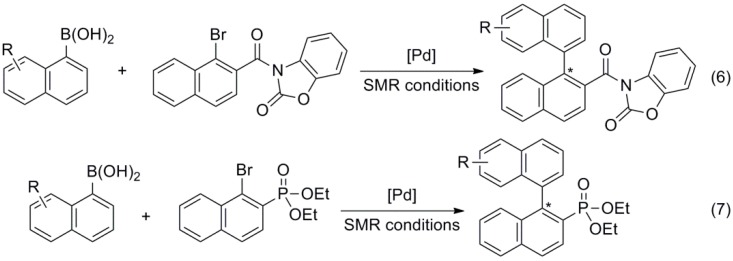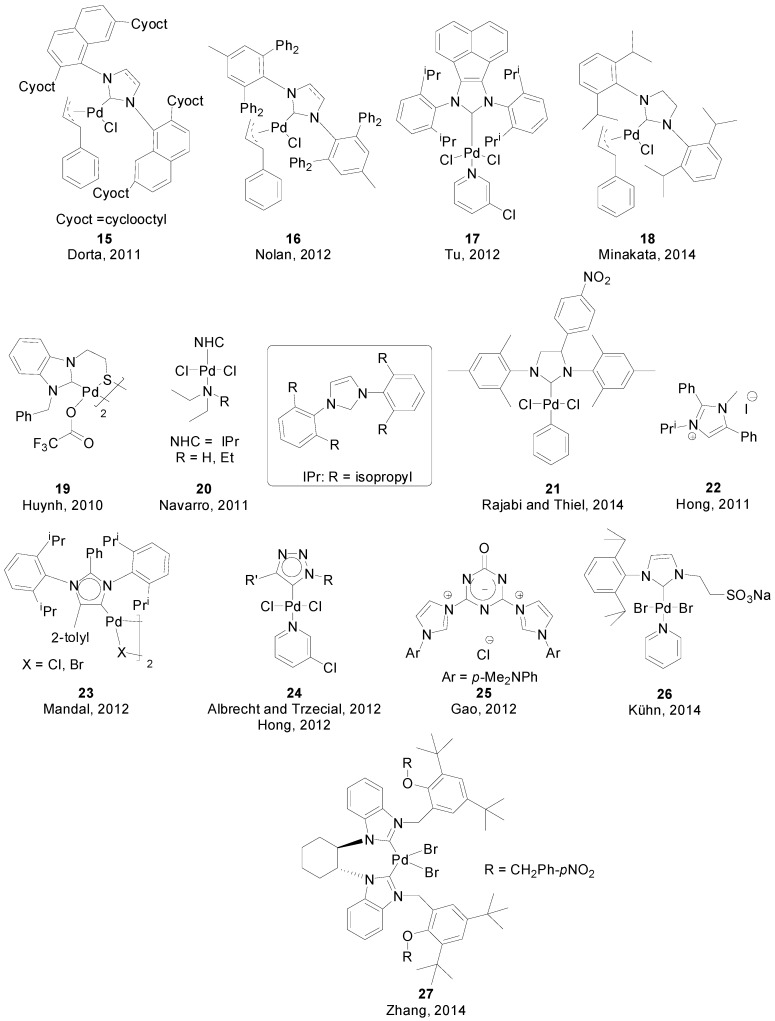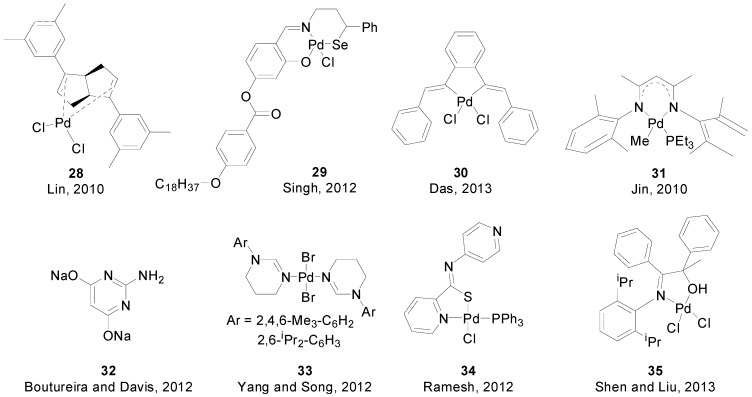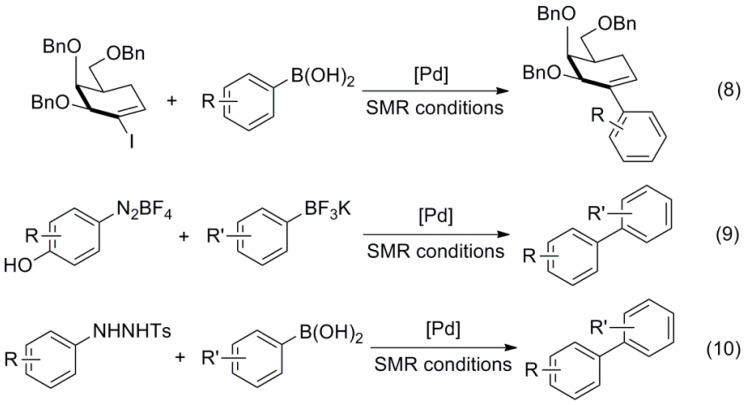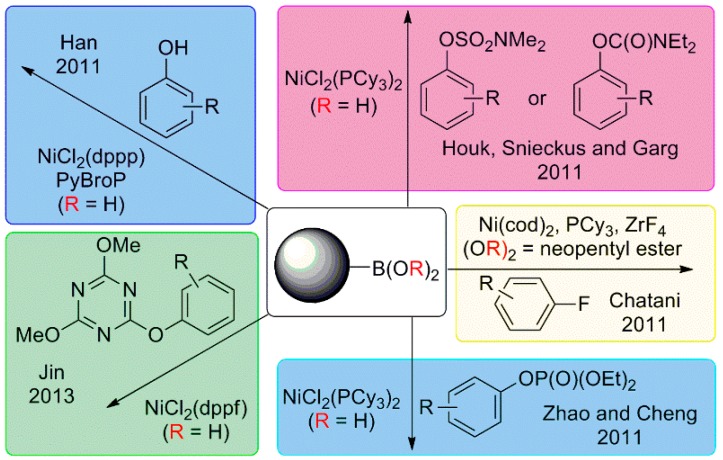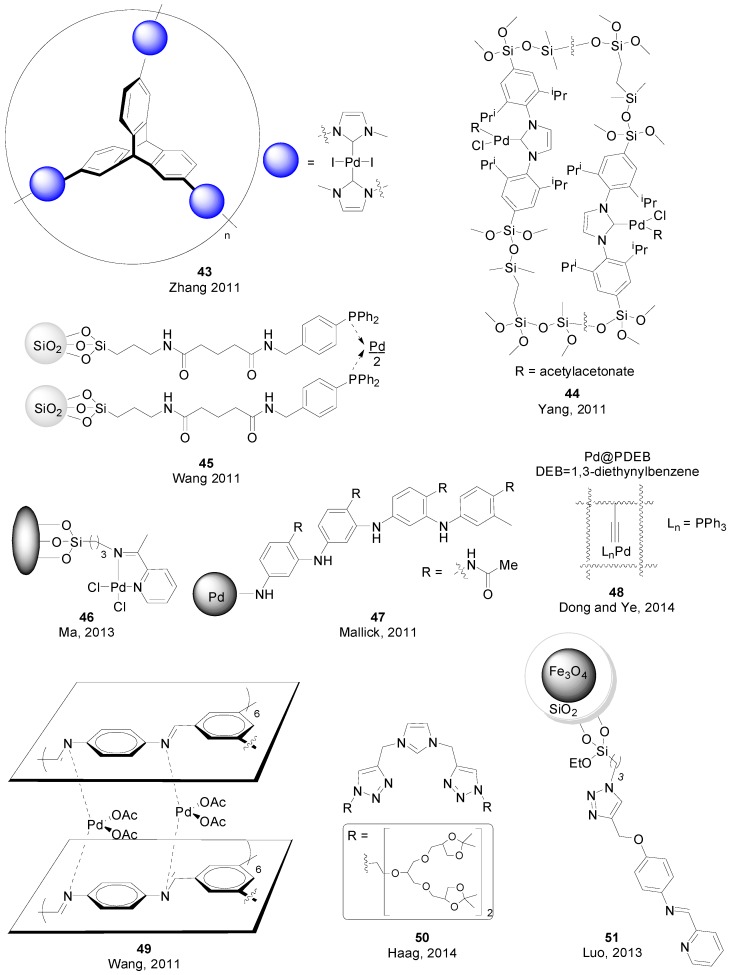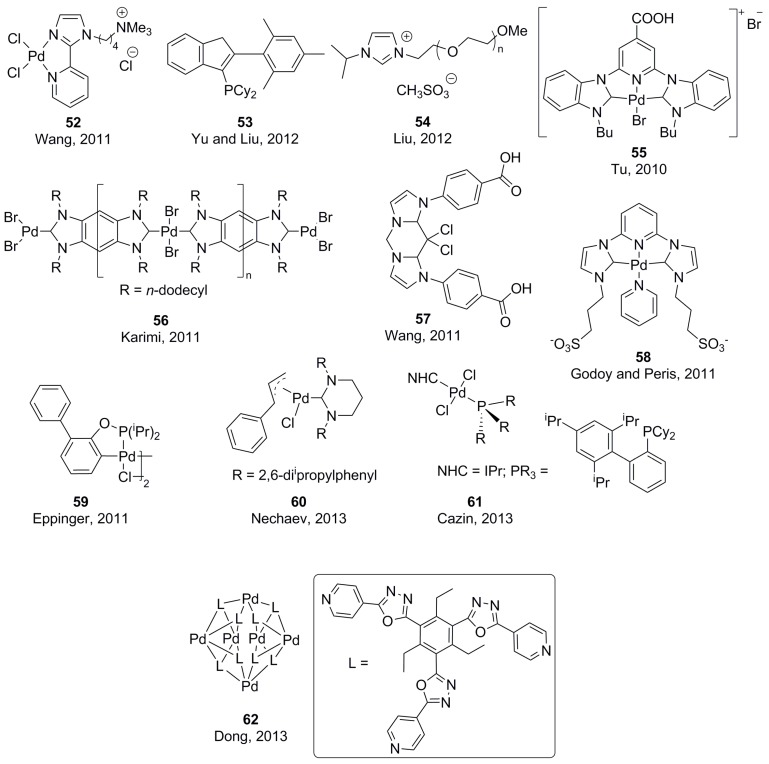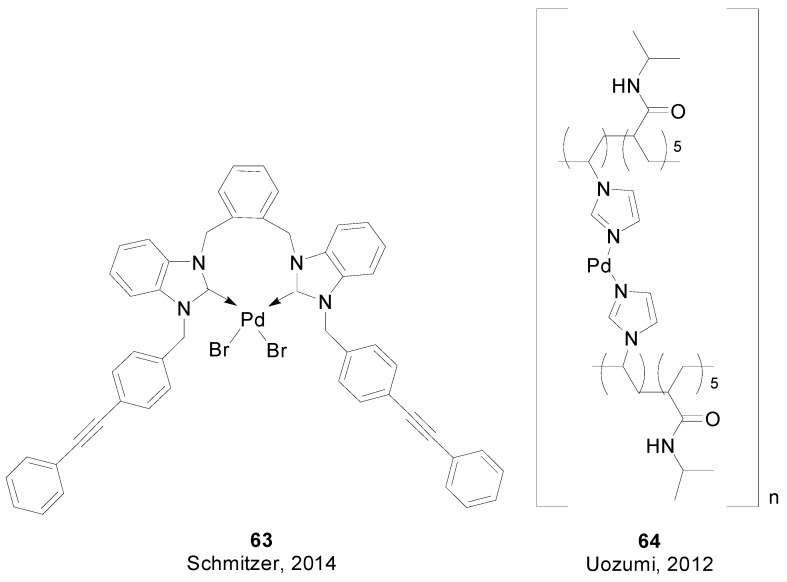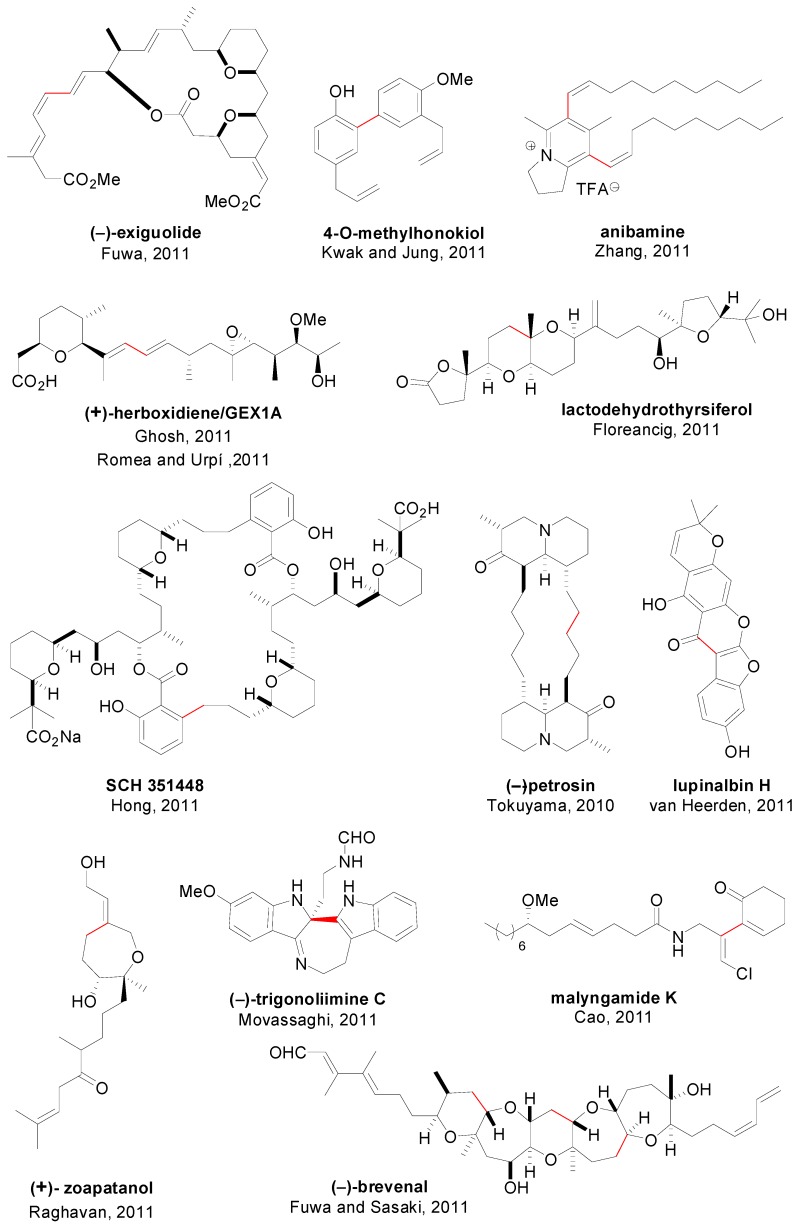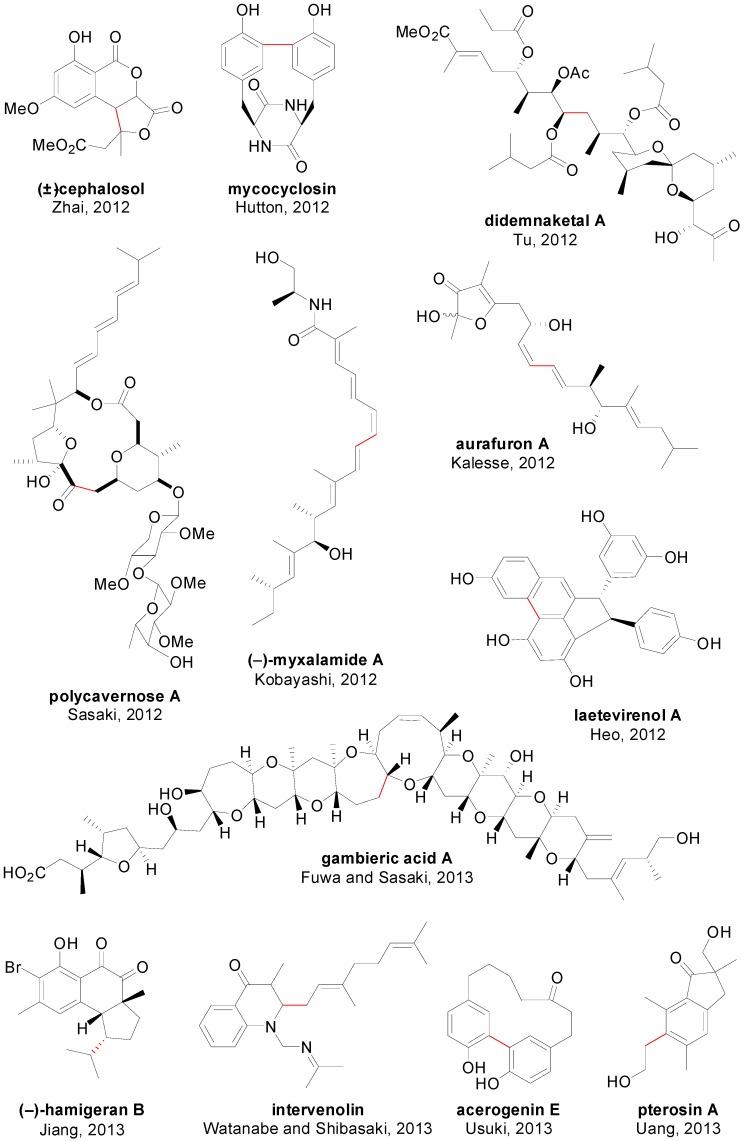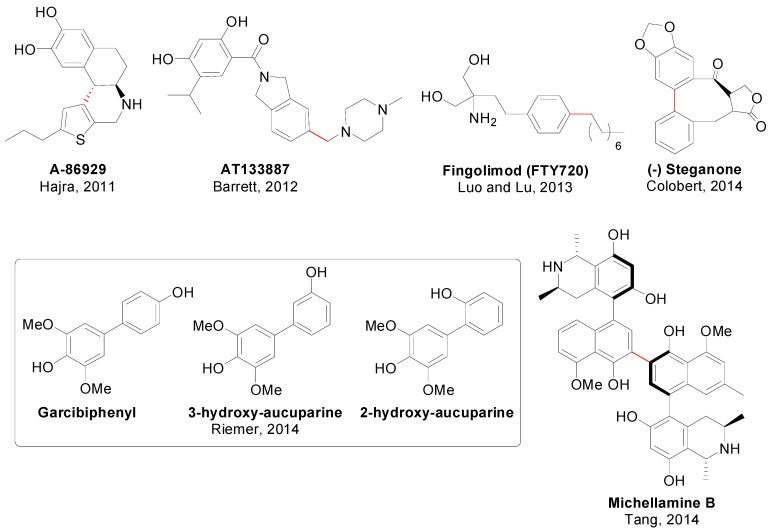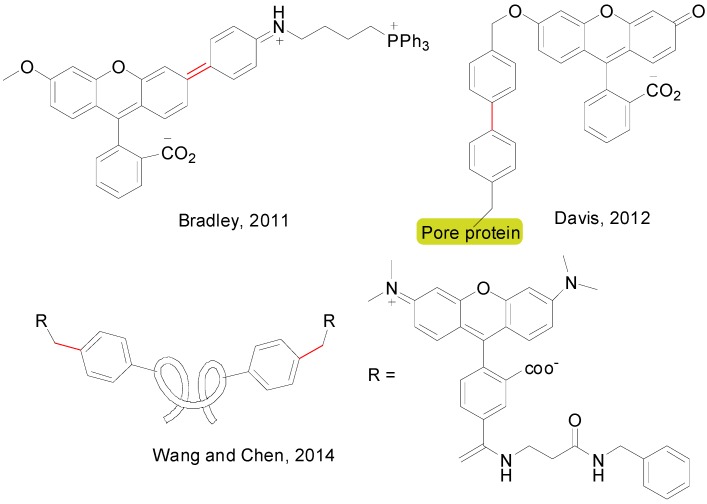Abstract
The Suzuki-Miyaura reaction (SMR), involving the coupling of an organoboron reagent and an organic halide or pseudo-halide in the presence of a palladium or nickel catalyst and a base, has arguably become one of most utilized tools for the construction of a C-C bond. This review intends to be general account of all types of catalytic systems, new coupling partners and applications, including the literature between September 2010 and December 2014.
Keywords: Suzuki-Miyaura, palladium, nickel, N-heterocyclic carbene, phosphine, polymerization
1. Introduction
Since its discovery in 1979 [1], the Suzuki-Miyaura reaction (SMR) [2,3,4,5], involving the coupling of an organoboron reagent and an organic halide or pseudo-halide in the presence of a palladium or nickel catalyst and a base, has arguably become one of most utilized tools for the construction of a C-C bond. The reaction follows an oxidative addition transmetallation reductive elimination catalytic cycle that benefits from the use of electron-donating, sterically demanding ligands which promote first and last steps [2]. Clear advantages over other palladium-catalyzed cross-coupling reactions [5] include: (i) mild reaction conditions; (ii) ready availability of organoboron reagents, which also are inert to water and related solvents, as well as oxygen, and generally thermally stable; (iii) tolerant toward various functional groups; and (iv) low toxicity of starting materials and by-products [6]. These features have allowed researchers to utilize it in a wide variety of applications, from natural product synthesis to the development of polymeric materials. Due to its impact in such a variety of fields, Akira Suzuki, together with Richard F. Heck and Ei-Ichi Negishi, was awarded in September 2010 the Nobel Prize in Chemistry “for palladium-catalyzed cross couplings in organic synthesis”. Since then, excellent and thorough reviews covering specific aspects of this reaction have been published: a historical account [7], and reviews focusing on Ni-catalyzed reactions [8], nanocatalysts [9], preformed Pd catalysts [10], sulphur-containing ligands [11,12], and the coupling of polyhalogenated heteroarenes [13]. This review intends to be a more general account of all types of catalytic systems, new coupling partners and applications, including the literature between September 2010 and December 2014. It is worth pointing out that a Scopus search on the topic “Suzuki coupling” lead to more than 3000 articles during that period; therefore, only a selection of the most significant developments and applications of the SMR are presented in here. In addition and for simplicity, details on the specifics of the reaction conditions (base, solvent, temperature) have been omitted unless any of those factors where determinant to the outcome, focusing mostly in coupling partners, ligands, metals and products.
2. Catalytic Systems
2.1. Homogeneous Systems
2.1.1. Palladium-Based Systems
Phosphane-Based Catalytic Systems
The SMR of non-aromatic coupling partners has been featured in several articles. Louie and co-workers devised a protocol for the coupling of heteroaryl boronic acids and vinyl chlorides using Pd(OAc)2 and SPhos at 85 °C. Interestingly, any increase or decrease of the temperature led to a lower yield of the desired product and an increase of protodeborilation of the boronic acid [14]. Also using Pd(OAc)2, Zhang developed a regioselective and stereospecific coupling of allylic carbonates with arylboronic acids using racemic BINAP as ligand, without added base and under mild reaction conditions [15]. Crudden and co-workers reported on the first regioselective SMR of secondary allylic boronic esters with aryl iodides, using Pd(PPh3)4 in the presence of Ag2O, where the regioselectivity was dictated by the pattern of olefin substitution [16]. More recently and in collaboration with Aggarwal, they reported the first cross-coupling of enantioselective chiral, enantioriched secondary allylic boronic esters, allowing to isolate high yields of major regioisomers by using Pd(dba)3, PPh3 and Ag2O [17].
Regarding the use of organoboranes other than the classic boronic acids and esters, Molander reported the coupling of potassium 1-(benzyloxy)alkyltrifluoroborates with aryl and heteroaryl chlorides [18] potassium Boc-protected aminomethyltrifluoroborates with aryl and heteroaryl mesylates [19] and sulfamates [20] and potassium cyclopropyl- and alkoxymethyltrifluoroborates with benzyl chlorides [21], using commercially available phosphines like RuPhos or SPhos (Scheme 1, Reactions (1)–(4)). Buchwald demonstrated that lithium triisopropyl borate salts can be used in SMR, and even devised a one-pot lithiation/borylation/SMR for the coupling of heteroarenes using complex 1 (Figure 1) as pre-catalyst (Scheme 1, Reaction (5)) [22].
Scheme 1.
SMR with new organoborane coupling partners.
Figure 1.
Phosphane-Pd complexes and phosphane ligands used in SMR.
Hong reported on the synthesis of two series of secondary phosphine oxide ligands and the use of some of those ligands in combination with Pd(OAc)2 (2 in 2011 and 3 in 2013) for SMR of aryl bromides and chlorides with phenylboronic acid [23,24].
Chelating phosphines and phosphine-bearing palladacycles are also common in SMR. Karami and co-workers prepared ortho-metallated complex 4 for the coupling or aryl bromides and chlorides under mild condition [25]. Lang synthesized chiral P,O-ferrocene 5a which, in combination with Pd2(dba)3 was applied in the coupling of nonactivated aryl bromides with aryl boronic acids at catalyst loadings as low as 1 ppm achieving quite high turnover numbers (TONs) of up to 750,000 [26]. Unfortunately, no atropselective SMR was observed. More recently, in 2014, two new bulky ferrocene supporting ligands 5b and 5c allowed for the synthesis of sterically congested tri-ortho-substituted byaryls under mild conditions [27,28]. Kwong and coworkers reported on the synthesis of CM-Phos (6), used in combination with Pd(OAc)2 for the coupling of alkenyl tosylates and mesylates [29]. Later, in collaboration with So, they prepared a 2nd generation of hemilable P,N-ligands, with 7 affording the best yields for the coupling of aryl mesylates in combination with Pd(OAc)2 [30]. Fernández and Lassaletta used complex 8, bearing a phosphino hydrazone, for asymmetric SMR leading to the formation of enantiomerically enriched biaryls under very mild reaction conditions [31].
Some phosphine-based protocols have been specifically devised for the coupling of sterically challenging substrates. Kwon reported on the synthesis of ligand 9, used in combination with Pd(OAc)2 for the synthesis of tri-ortho-substituted biaryls [32]. Di- and tri-ortho-substituted biaryls were prepared by Shaughnessy using trineopentylphosphine (10) [33]. Ligands 11a and 11b were designed by Tang and used for the synthesis of tetra-ortho-substituted biaryls by coupling aryl iodides, bromides and chlorides with boronic acids in excellent yields [34]. Previously, this group had reported on the use of similar ligands 12 in the synthesis of axially chiral byaryls in high yields and enantioselectivities, coupling aryl boronic acids with 3-(1-bromo-2-naphthoyl)benzo[d]oxazol-2(3H)-one and 1-bromo-2-naphtylphosphonate (Scheme 2) [35]. The same substrate was also the choice of Qiu and co-workers to test ligand 13 [36], and of Suginome and co-workers to test novel helically chiral ligands [37].
Scheme 2.
Synthesis of axially chiral biaryls.
Zwitterionic phosphine palladium complex 14, prepared by Lee and coworkers in 2014, has shown high efficiency in the Suzuki-Miyaura reaction of sterically hindered substrates at room temperature, coupling ortho- and di-ortho-substituted aryl chlorides, heterocyclic and anthracenyl rings and even performed double arylations in good yields [38].
N-heterocyclic Carbene (NHC)-Based Systems
Regarding the development of protocols specifically devised for the coupling of sterically challenging substrates, Dorta reported in 2011 the synthesis of complex 15 (Figure 2), which could perform room-temperature Suzuki-Miyaura synthesis of tetra-ortho-substituted biaryls.[39] Later, in 2012, Cazin and Nolan reported the synthesis of (IPr*)Pd(cinnamyl)Cl] 16, also featuring a bulky NHC, that performed similar couplings using a lower catalyst loading when compared to Dorta’s [40]. The same year, Tu described the synthesis of complex 17, which allowed for the synthesis of tetra-ortho-substituted biaryls in excellent yields, albeit at higher temperature (80 °C) [41]. Another complex of the same family, [(SIPr)Pd(cinnamyl)Cl] 18, was applied by Minakata very recently in the stereospecific and regioselective cross-coupling of 2-arylaziridines with arylboronic acids to obtain configurationally defined arylphenethylamine derivatives [42].
Figure 2.
(NHC)-Pd complexes and NHC ligands used in SMR.
Yuan and Huynh prepared a series of dinuclear and tetranuclear Pd(II) complexes of a thiolato-functionalized NHC [43]. Complex 19 was used as catalyst in SMR of aryl bromides using catalyst loadings as low as 0.0025 mol %. Navarro and co-workers reported the synthesis of (NHC)PdCl2(TEA) and (NHC)PdCl2(DEA) (TEA = triethylamine, DEA = diethylamine) complexes 20 [44,45]. While the TEA-bearing complex exhibited high activity for the coupling of aryl chlorides at room temperature, the DEA-bearing complex required higher reaction temperature (80–90 °C) to match that activity. The authors concluded that while TEA-bearing complex activated faster, leading to the catalytically active species (NHC)-Pd(0), DEA-bearing complexes are more stable due to an rare intramolecular H-bonding between a chlorine and DEA.
Rajabi and Thiel used complex 21 for the cross-coupling of both activated and deactivated aryl chlorides with phenyl, naphtyl and thiopheneboronic acids at room temperature in aqueous medium [46] Hong [47] and Mandal [48] explored the utilization of “abnormal” NHCs (aNHCs) [43] for SMR: [49] while Hong made use of ligand 22 in combination with Pd(OAc)2 for the coupling of aryl bromides, Mandal used complexes 23 for the coupling of aryl chlorides at room temperature.
Very similar complexes 24 containing C5-bound 1,2,3-triazolylidene Pd complexes containing a 3-chloropyridine ligand were independently prepared by Albrecht and Trzeciak [50] and Hong [51] in 2012, where the only difference is the identity of the R-substituents: Hong’s had 2,6-diipropylphenyl groups while Albrecht explored a wide variety of aryl and alkyl substituents.
Zou and co-workers reported a general protocol for SMR of aryl bromides and chlorides and diarylborinic acids and anhydrides catalyzed by an in situ-generated combination Pd/IPr/P(OPh)3 in a 1:1:2 ratio [52]. Gao prepared a series of novel bisimidazolium pincer ligands, and 25 was used in combination with Pd(OAc)2 for the coupling of aryl bromides using catalyst loadings as low as 0.005 mol% [53].
More recently, Kühn synthesized a sulfonated water-soluble PEPPSI-Pd-NHC 26 complex with good recyclability and performed couplings of aryl chlorides and bromides at room temperature [54]. Zhang prepared a chiral bis-NHC palladium catalyst 27 for asymmetric Suzuki-Miyaura couplings of aryl bromides and chlorides in good yields, observing a strong steric effect of the aromatic substituents on the enantiocontrol of the reaction [55].
Other Ligands and Ligandless Systems
A wide variety of other ligands have been used for SMR. In 2010, Lin and co-workers synthesized chiral complex 28 (Figure 3) and used it, in combination with an extra amount of ligand, for catalytic asymmetric SMR leading to the formation of axially chiral biaryls at room temperature, in excellent yields and good enantioselectivities [56]. Schiff bases have been used as ligands by Singh [57] (29) and Das [58] (30). While Singh’s was only tested for the coupling of aryl bromides, the latter allowed for the coupling of activated and unactivated aryl chlorides.
Figure 3.
Complexes and ligands used in SMR.
Nitrogen ligands are also very common. In 2011 Jin and Lee synthesized a series of β-diketiminato-phosphine-Pd complexes, being complex 31 the most active for the coupling of mono- and polychlorinated arenes in excellent yields [59]. Boutureira and Davis reported on a general method for the synthesis of 2-arylglycals by coupling 2-iodoglycals with arylboronic acids in aqueous media (Reaction (8), Scheme 3), using L2Pd(OAc)2 as catalyst (L = 32) [60]. In 2012, Yang and Song synthesized complexes 33 and used them as catalysts for the coupling of aryl bromides and phenyl chloride with phenyl- and 1-naphthylboronic acid [61]. The same year, Ramesh reported the synthesis of complex 34 for the coupling of deactivated aryl bromides and bromopyridines [62]. More recently, Shin and Liu used complex 35 as catalyst for the coupling of a variety of bromides at mild temperatures (rt—60 °C) [63].
Scheme 3.
SMR of 2-iodoglycals, phenoldiazonium salts and N'-tosylarylhydrazines.
In this period, a series of articles have stressed the advantages and simplicity of ligandless systems, being Pd(OAc)2 the catalyst of choice in many cases. For instance, Schmidt used this salt for the coupling of phenoldiazonium salts with potassium trifluoroborates at room temperature [64], while Lu carried out SMR of N'-tosylarylhydrazines (Reactions (9), (10), Scheme 3) [65]. In addition, Liu described the synthesis synthesis of heteroaryl-substututed triphenylamine derivatives by coupling heteroaryl halides with 4-(diphenylamino)phenylboronic acid [66].
2.1.2. Nickel-Based Systems
Although Pd-catalyzed protocols have been by far the most investigated, the first example of Ni-catalyzed SMR was reported almost two decades ago by Percec and co-workers [67]. An increasingly growing interest in the use of Ni catalysts has led to important developments in this area [8].
The most significant feature is the variety of protocols that have been developed to couple other electrophiles than the classic aryl iodides, bromides or chlorides (Scheme 4). Phenols [68,69], carbamates and sulfamates [70,71], fluorides [72], phosphates [73] and heteroaryl ethers [74] have been successfully coupled with organoboron reagents with excellent results. In addition, Hartwig reported on the coupling of heteroaryl boronic acids with heteroaryl halides using low loadings of (dppf)Ni(cinnamyl)Cl under very mild reaction conditions [75].
Scheme 4.
Ni-catalyzed SMR using phosphine ligands.
A handful of examples of (NHC)-Ni(II) systems have been reported. Although oftentimes their activity in SMR is not particularly extraordinary, they are worth mentioning to account for and promote the research in this subarea. In 2010, Tu and co-workers reported on the use of complex 36 (Figure 4) in combination with PPh3 for the coupling or aryl bromides, chlorides, tosylates and mesylates with phenyl boronic acid in good to excellent yields [76]. Radius and co-workers reported on interesting studies on the activation of aryl chlorides and bromides through oxidative addition to (NHC)2Ni(0) species [77,78]. More recently, Chetcuti and Ritleng reported on the synthesis of (NHC)Ni(Cp)X complexes 37 and 38 for the coupling of bromo- and chloroarenes [79]. While complex 39 could perform some couplings in low to moderate yields, immobilized complexes 40 displayed a much lower activity.
Figure 4.
(NHC)nNi(II) complexes used as catalysts in SMR.
In 2012, Roglans and Pörschke reported on the use of a series of nickel (0) complexes of polyunsaturated azamacrocyclic ligands (39 and related structures, Figure 5) for the SMR of arylboronic acids and aryl halides [80]. The same year, Fu and co-workers reported the use of carbamates, sulphonamides and sulfones as directing groups in Ni-catalyzed SMR, achieving the asymmetric coupling of unactivated alkyl electrophiles at room temperature (Scheme 5) [81]. The catalyst was formed in situ by combining either ligand 40 or ligand 41 and NiBr2·diglyme. Later, the same group reported on the use of ligand 42 in a similar system for the coupling of unactivated tertiary alkyl electrophiles [82].
Figure 5.
Ni(0) complex and ligands used in Ni-catalyzed SMR.
Scheme 5.
Ni-catalyzed asymmetric coupling of unactivated alkyl electrophiles.
2.1.3. Iron-Based Systems
Recently, iron has entered the SMR arena. In 2012, Hu and co-workers performed theoretical and experimental studies on the mechanism and regioselectivity of iron-catalyzed direct SMR of pyridine and phenylboronic acid [83]. The authors found that the overall reaction includes three steps, somewhat similar to the regular SMR catalytic cycle: C-H activation, transmetalation, and reductive elimination. The same year, Nakamura and co-workers reported on iron-catalyzed SMR of alkyl bromides with in situ-prepared magnesium tetraalkylborates under very mild reaction conditions [84] and the stereospecific coupling of alkenylboronates and alkyl halides [85].
2.2. Heterogeneous Systems
Heterogeneous catalysts generally offer the advantage of simple separation and recovery, allowing in many cases for high level of recyclability. With this goal in mind, Yang and co-workers synthesized an NHC-functionalized mesoporous ethane-silica material and a subsequent series of Pd-bearing derivatives, finding that material 43 (Figure 6) could catalyze very challenging couplings involving deactivated and sterically demanding aryl chlorides under relatively mild conditions [86]. Zhang and co-workers prepared NHC-containing, triptycene-based main-chain organometallic polymer 44, which could be used as a recyclable catalysts for SMR of aryl halides and phenylboronic acid [87]. Silica-supported Pd-phosphine complex 45 was prepared by Wang and used for SMR of aryl iodides, bromides and activated chlorides at room temperature [88]. Very recently, Ma and co-workers synthesized immobilized complex 46, which was used as catalyst for the coupling of aryl iodides and bromides with phenyl- and 4-methylphenylboronic acid under air atmosphere [89].
Figure 6.
Heterogeneous complexes and ligands for SMR.
Palladium nanoparticles are common in heterogeneous systems and several examples were reported in this period. For instance, Martins and co-workers reported the use of a palladium colloidal solution stabilized with polyvinylpyrrolidone for microwave-assisted SMR of aryl iodides and bromides [90]. Mallick and co-workers synthesized Pd-poly(amino acetanilide) composite 47, which was used in SMR of aryl and heteroaryl bromides with aryl and heteroaryl boronic acids [91]. Magdesieva and Vorotyntsev reported a series of polypyrrole-Pd nanocomposites that could be recycled when the particles were immobilized in a graphite tissue [92]. Guo and co-workers entrapped Pd nanocrystals in solution-dispersible, poly(p-phenyleneethynylene)-based conjugated nanoporous polymer colloids and used them as highly active and recyclable catalysts for the coupling of aryl bromides with phenylboronic acid [93]. Self-encapsulated Pd(II) catalyst 48 was synthesized via cross-linking of 1,3-diethynylbenzene with Pd(OAc)2/PPh3, by Dong and Ye and used in cross-coupling reactions [94], at ppm to ppb palladium loadings with high recyclability and TONs as high as 3.2 × 106.
In 2011, Wang and co-workers constructed a two-dimensional layered, imine-based covalent organic framework that incorporated Pd(OAc)2 between layers 49. This material was applied to the SMR of aryl iodides and bromides with excellent recyclability [95]. Later in 2014, Haag reported N-heterocyclic carbene palladium ligands that were supported on glycerol-dendrons 50, with the catalytic site at the core position, allowing for cross-coupling reactions to take place with catalyst loadings as low as 0.00001 mol % and high TON values [96].
In recent years, the synthesis of Fe3O4-supported catalysts that can be separated from the reaction mixture by an external magnet, avoiding laborious separation steps and allowing for an easy reuse, has attracted much attention [97]. Yang and Qin synthesized magnetic silica nanoparticles functionalized with an NHC by co-condensation of IPr carbene-bridged organosilane and tetraalkoxysilane. After coordinating Pd(acac)2, these particles were able to catalyze SMR of several aryl bromides and chlorides in isopropanol [98].
Yiang and Sun described the excellent activity of Fe3O4 and Pd nanoparticles assembled on sulfonated graphene for SMR of aryl bromides and aryl boronic acids [99]. Li and Ma described a method to stabilize Pd(0) on the surface of hollow magnetic mesoporous silica spheres with Fe3O4 nanoparticles embedded in the mesoporous shell [100], and used this heterogeneous catalyst for the coupling of various aryl halides with phenylboronic acid. Luo and co-workers treated magnetic nanoparticles 51 with a methanolic solution of Na2Pd2Cl6 under reflux conditions to obtain a catalyst that was used for the coupling of aryl bromides and iodides with arylboronic acids in high yields [101]. Very recently, Hyeon and co-workers prepared highly recyclable magnetic hollow nanocomposite catalysts with a permeable carbon surface, which were tested for SMR of aryl iodides and bromides with phenylboronic acid in excellent yields [102].
2.3. Reactions in Water
It is estimated that around 80% of the chemical waste from a reaction mixture corresponds to the solvent [103]. From environmental, economic and safety points of view, the use of water as solvent in organic reactions is a clear goal, although challenging and in most cases requiring of high reaction temperatures. In the case of the SMR, the stability of boronic acids in aqueous media gives it an advantage over other cross-coupling reactions to implement water as a solvent.
2.3.1. Homogeneous Systems
In 2011, Wang and co-workers reported the synthesis of chelating complex 52 (Figure 7) and its application for SMR in air and water at 120 °C, allowing for the coupling of aryl chlorides and bromides in excellent yields [104]. Yu and Liu also reported on the coupling of aryl chlorides using an in situ generated catalytic system with Pd(OAc)2 and ligand 53, at 100 °C and in the presence of a quaternary ammonium salt [105]. The same temperature and Pd salt was needed for Liu’s in situ system involving the use of NHC precursor 54 for the coupling of mostly bromides [106]. Well-defined NHC-based catalysts for SMR in water were reported by Tu (55) [107], Karimi (56) [108], Wang (57) [109] and Godoy and Peris (58) [110]. Karimi reported later on a water-soluble (NHC)-Pd polymer similar to 56, in which the N-groups were replaced by triethylene glycol. This polymer showed very high activity for the coupling of aryl chlorides, together with excellent recyclability [111]. The same year, Eppinger and co-workers used palladacycle 59, under air and at room temperature, for the coupling of aryl iodides and bromides with a variety of boronic acids [112]. Very recently, Nechaev and co-workers synthesized complex 60, which was used for the coupling of heteroaryl bromides and chlorides [113]. The same year Cazin and co-workers reported on the synthesis of a series of mixed PR3/NHC Pd complexes 61 that were used in SMR of aryl chlorides using very low catalysts loadings and in an aqueous medium (water-isopropanol 9:1) [114]. A self-assembled nano-sized Pd6L8 (L = 1,3,5-tris(4'-pyrirdyloxadiazol)-2,4,6-triethylbenzene) ball 62 was constructed by Dong for Suzuki-Miyaura coupling reactions at catalysts loadings of ppm [115]. The system allowed to tailor between a homogeneous or heterogeneous format depending on the solubility in different solvents under ambient conditions.
Figure 7.
Ligands and complexes for homogeneous SMR in water.
2.3.2. Heterogeneous Systems
In 2010, Huang and co-workers reported on the use of Pd nanoparticles on a porous ionic copolymer of an ionic liquid and divinybenzene for the coupling of aryl bromides and chlorides under air and in water, using Pd loadings as low as 10 ppm [116].
Hu and co-workers embedded Pd nanoparticles in carbon thin film-lined nanoreactors with good results, reproducible even after reusing the catalyst five times [117], while Firouzabadi and Iranpoor used agarose hydrogel to contain the Pd [118]. The use of Pd salts seems to allow for milder reaction conditions: Ma and Lei prepared a heterogenous biopolymer complex wool-PdCl2 that performed couplings of aryl chlorides [119] and Li and co-workers used highly recyclable monodispersed zeolitic hollow spheres containing PdCl2(pyridine)2 to couple aryl bromides and iodides in 60% aqueous ethanol solutions [120]. Bora [121] and Qiu and Liu have recently shown that the solely use of PdCl2 and Pd(OAc)2, respectively, in the presence of an adequate base can couple a variety of aryl bromides in water [122].
The use of unsupported Pd-NHC complex 63 (Figure 8) was reported by Schmitzer [123]. This heterogeneous catalyst was used in low loadings for SMR in a green procedure with very good recyclability. Yamada and Uozumi developed a metalloenzyme-inspired polymer catalyst: [124] a self-assembled catalyst of poly(imidazole-acrylamide) and palladium species 64 that promoted the allylic arylation, alkenylation, and vynilation of allylic esters with aryl/alkenylboronic acids in water with catalytic turnover numbers of 20,000–1,250,000.
Figure 8.
Heterogeneous catalysts for SMR in water.
A few examples of magnetically recoverable systems which undergo reactions in water appeared in 2014. An example was reported by Wand and Li in which a mesoporous magnetic organometallic catalyst promoted SMR in water with high efficiency using as low as 0.002 mol % of Pd (II) [125]. Eight reaction cycles were run without significant decrease in selectivity after which it was recovered by an external magnet.
3. Applications
3.1. SMR in Natural Products and Drugs Synthesis
An account of natural products in which at least one step involved a SMR is depicted in Figure 9 [126,127,128,129,130,131,132,133,134,135,136,137,138] and Figure 10 [139,140,141,142,143,144,145,146,147,148,149,150]. For each compound, the corresponding authors, the year and the bond constructed using a SMR are showed. It is worth of mention that despite the advances in catalyst development in the last 10–15 years, it is rare to find examples in the literature in which the catalyst employed for this often crucial step in the synthesis is different than simply Pd(PPh3)4, PdCl2(dppf) or Pd(OAc)2 in combination with PPh3 or Ph3As [140,144,149,150]. Regarding the use of SMR in drug synthesis only eight examples are shown (Figure 11) [151,152,153,154,155], although this methodology has been used for the synthesis of many libraries of compounds with biological activity [156,157,158]. Some examples have also included SMR for the coupling of amino acids [159] and in chemical transformations in living organisms mediated by synthetic metal complexes (Figure 12), like an intracellular SMR using a cell penetrating Pd[0]-nanocatalyst [160] and the coupling between a modified pore protein with a boronic acid on the surface of E. coli [161].
Figure 9.
SMR in natural product synthesis (I).
Figure 10.
SMR in natural product synthesis (II).
Figure 11.
SMR in drug synthesis.
Figure 12.
SMR in living organisms.
3.2. Polymerizations
The SMR, often referred in this area as “Suzuki polycondensation” (SPC), is a preferred protocol for the synthesis of polyarylenes and related unsaturated polymers [162]. The SPC follows, in most cases [163], a step-growth mechanism with conversions per bond formation step up to 99.99%, making it very attractive for the synthesis of well-defined polymers with specific optical and electronic properties. Both AA/BB and AB polymerizations are common (AA/BB referring to a diboronate coupled with a dihalide, AB referring to a single monomer containing both functionalities), although the first approach is favoured due to an easier functionalization of the monomers. Figure 13 depicts a series of polymers developed since September 2010.
Figure 13.
Polymers synthesized using SMP.
Interestingly, almost all polymers in this list were prepared using Pd(PPh3)4 or Pd(OAc)2 as catalysts [164,165,166,167,168,169,170,171,172], although there are some exceptions [173,174,175,176,177,178]. Focussing more in the catalyst employed and carrying out a catalyst screening for a specific polymerization is gradually becoming more and more common [139,140,141,142,143,144,145,146,147,148,149,150,179,180,181].
4. Closing Remarks
Almost thirty five years after its discovery, the Suzuki-Miyaura reaction is more present than ever in the laboratories of researchers from varied disciplines, including both ends of the spectrum: the people that develop new methodology (new catalysts, new coupling partners) and the people that apply it in their field (materials, synthesis, etc.). Although there is a clear disconnection between the newest catalyst development and its application in other areas, fortunately the use of more active and selective catalysts that can couple more challenging substrates, even under milder reaction conditions, is lately becoming more common.
Author Contributions
ON and IM wrote this review. All authors read and approved the final manuscript.
Conflicts of Interest
The authors declare no conflict of interest.
References
- 1.Miyaura N., Yamada K., Suzuki A. A new stereospecific cross-coupling by the palladium-catalyzed reaction of 1-alkenylboranes with 1-alkenyl or 1-alkynyl halides. Tetrahedron Lett. 1979;20:3437–3440. doi: 10.1016/S0040-4039(01)95429-2. [DOI] [Google Scholar]
- 2.Miyaura N. Cross-coupling reactions: A practical guide. Top. Curr. Chem. 2002;219:11–59. [Google Scholar]
- 3.Tsuji J. Palladium Reagents and Catalysis. 2nd ed. Wiley; West Sussex, UK: 2004. [Google Scholar]
- 4.De Meijere A, Diederich F. Metal-Catalyzed Cross-Coupling Reactions. 2nd ed. Wiley-VCH; Weinheim, Germany: 2004. [Google Scholar]
- 5.Negishi E. Handbook of Organopalladium Chemistry for Organic Synthesis. Wiley-Interscience; New York, NY, USA: 2002. [Google Scholar]
- 6.Suzuki A. Cross-coupling reactions via organoboranes. J. Organomet. Chem. 2002;653:83–90. doi: 10.1016/S0022-328X(02)01269-X. [DOI] [Google Scholar]
- 7.Johansson Seechurn C.C.C., Kitching M.O., Colacot T.J., Snieckus V. Palladium-catalyzed cross coupling: A historical contextual perspective to the 2010 Nobel Prize. Angew. Chem. Int. Ed. 2012;51:5052–5085. doi: 10.1002/anie.201107017. [DOI] [PubMed] [Google Scholar]
- 8.Han F.S. Transition-metal-catalyzed Suzuki-Miyaura cross-coupling reactions: A remarkable advance from palladium to nickel catalysts. Chem. Soc. Rev. 2013;42:5270–5298. doi: 10.1039/c3cs35521g. [DOI] [PubMed] [Google Scholar]
- 9.Fihri A., Bouhrara M., Nekoueishahraki B., Basset J.M., Polshettiwar V. Nanocatalysts for Suzuki cross-coupling reactions. Chem. Soc. Rev. 2011;40:5181–5203. doi: 10.1039/c1cs15079k. [DOI] [PubMed] [Google Scholar]
- 10.Li H., Johansson Seechurn C.C.C., Colacot T.J. Development of preformed Pd catalysts for cross-coupling reactions, beyond the 2010 Nobel Prize. ACS Catal. 2012;2:1147–1164. doi: 10.1021/cs300082f. [DOI] [Google Scholar]
- 11.Kumar A., Rao G.K., Kumar S., Singh A.J. Organosulphur and related ligands in Suzuki-Miyaura C-C coupling. Dalton Trans. 2013;42:5200–5223. doi: 10.1039/c2dt32432f. [DOI] [PubMed] [Google Scholar]
- 12.Yuan D., Huynh H.V. Sulfur-functionalized N-heterocyclic carbene complexes of Pd(II): Syntheses, structures and catalytic activities. Molecules. 2012;17:2491–2517. doi: 10.3390/molecules17032491. [DOI] [PMC free article] [PubMed] [Google Scholar]
- 13.Rossi R, Bellina F., Lessi M. Selective Palladium-catalyzed Suzuki-Miyaura reactions of polyhalogenated heteroarenes. Adv. Synth. Catal. 2012;354:1181–1255. doi: 10.1002/adsc.201100942. [DOI] [Google Scholar]
- 14.Thakur A., Zhang A. Suzuki-Miyaura coupling of heteroaryl boronic acids and vinyl chlorides. Chem. Commun. 2012;48:203–205. doi: 10.1039/C1CC15990A. [DOI] [PubMed] [Google Scholar]
- 15.Li C., Xing J., Zhao J., Huynh P., Zhang W., Jiang P., Zhang Y.J. Pd-catalyzed regioselective and stereospecific Suzuki-Miyaura coupling of allylic carbonates with aryl boronic acids. Org. Lett. 2012;14:390–393. doi: 10.1021/ol203154j. [DOI] [PubMed] [Google Scholar]
- 16.Glasspoole B.W., Ghozati K., Moir J.W., Crudden C.M. Suzuki–Miyaura cross-couplings of secondary allylic boronic esters. Chem. Commun. 2012;48:1230–1232. doi: 10.1039/C2CC16076E. [DOI] [PubMed] [Google Scholar]
- 17.Chausset-Boissaire L., Ghozati K., LaBine E., Chen J.L.-Y., Aggarwal V.K., Crudden C.M. Enantiospecific, regioselective cross-coupling reactions of secondary allylic boronic esters. Chem. Eur. J. 2013;19:17698–17701. doi: 10.1002/chem.201303683. [DOI] [PubMed] [Google Scholar]
- 18.Molander G.A., Wisniewski S.R. Stereospecific cross-coupling of secondary organotrifluoroborates: Potassium 1-(benzyloxy)alkyltrifluoroborates. J. Am. Chem. Soc. 2012;134:16856–16868. doi: 10.1021/ja307861n. [DOI] [PMC free article] [PubMed] [Google Scholar]
- 19.Molander G.A., Shin I. Suzuki-Miyaura cross-coupling reactions of potassium Boc-protected aminomethyltrifluoroborate with aryl and hetaryl mesylates. Org. Lett. 2012;14:3138–3141. doi: 10.1021/ol301221p. [DOI] [PMC free article] [PubMed] [Google Scholar]
- 20.Molander G.A., Shin I. Pd-Catalyzed Suzuki-Miyaura cross-coupling reactions between sulfamates and potassium Boc-protected aminomethyltrifluoroborates. Org. Lett. 2013;15:2534–2537. doi: 10.1021/ol401021x. [DOI] [PMC free article] [PubMed] [Google Scholar]
- 21.Colombel V., Rombouts F., Oehlrich D., Molander G.A. Suzuki coupling of potassium cyclopropyl- and alkoxymethyltrifluoroborates with benzyl chlorides. J. Org. Chem. 2012;77:2966–2970. doi: 10.1021/jo202686p. [DOI] [PMC free article] [PubMed] [Google Scholar]
- 22.Oberli M.A., Buchwald S.L. A general method for Suzuki-Miyaura coupling reactions using lithium triisopropyl borates. Org. Lett. 2012;14:4606–4609. doi: 10.1021/ol302063g. [DOI] [PMC free article] [PubMed] [Google Scholar]
- 23.Hu D.F., Weng C.M., Hong F.E. Preparation of new Buchwald-type secondary phosphine oxide ligands and applications in Suzuki-Miyaura reactions. Organometallics. 2011;30:1139–1147. doi: 10.1021/om101132t. [DOI] [Google Scholar]
- 24.Chang Y.Y., Hong F.E. Preparation and application of indolyl secondary phosphine oxides in palladium complexes catalyzed Suzuki-Miyaura cross-coupling reaction. Tetrahedron. 2013;69:2327–2335. doi: 10.1016/j.tet.2013.01.013. [DOI] [Google Scholar]
- 25.Karami K., Rizzoli C., Salah M.M. Synthesis and application of ortho-palladated complex of (4-phenylbenzoylmethylene)triphenylphosphorane as a highly active catalyst in the Suzuki cross-coupling reaction. J. Organomet. Chem. 2011;696:940–945. doi: 10.1016/j.jorganchem.2010.10.025. [DOI] [Google Scholar]
- 26.Schaarschmidt D., Lang H. P,O-ferrocenes in Suzuki-Miyaura C,C couplings. ACS Catal. 2011;1:411–416. doi: 10.1021/cs200065v. [DOI] [Google Scholar]
- 27.Korb M., Schaarschmidt D., Lang H. Anionic phospho-Fries rearrangement at ferrocene: one-pot approach to P,O-substituted ferrocenes. Organometallics. 2014;33:2099–2108. doi: 10.1021/om5002827. [DOI] [Google Scholar]
- 28.Schaarschmidt D., Grumbt M., Hildebrandt A., Lang H. A Planar-Chiral Phosphino(alkenyl)ferrocene for Suzuki-Miyaura C-C Coupling Reactions. Eur. J. Org. Chem. 2014;30:6676–6685. doi: 10.1002/ejoc.201402861. [DOI] [Google Scholar]
- 29.Wong P.Y., Chow W.K., Chung K.H., So C.M., Lau C.P., Kwong F.Y. A versatile palladium catalyst system for Suzuki-Miyaura coupling of alkenyl tosylates and mesylates. Chem. Commun. 2011;47:8328–8330. doi: 10.1039/c1cc12240a. [DOI] [PubMed] [Google Scholar]
- 30.Chung K.H., So C.M., Wong S.M., Luk C.H., Zhou Z., Lau C.P., Kwong F.Y. An efficient palladium-benzimidazolyl phosphine complex for the Suzuki-Miyaura coupling of aryl mesylates: Facile ligand synthesis and metal complex characterization. Chem. Commun. 2012;48:1967–1969. doi: 10.1039/c2cc15972d. [DOI] [PubMed] [Google Scholar]
- 31.Ros A., Estepa B., Bermejo A., Álvarez E., Fernández R., Lassaletta J.M. Phosphino hydrazones as suitable ligands in the asymmetric Suzuki-Miyaura cross-coupling. J. Org. Chem. 2012;77:4740–4750. doi: 10.1021/jo300548z. [DOI] [PubMed] [Google Scholar]
- 32.To S.C., Kwong F.Y. Highly efficient carbazolyl-derived phosphine ligands: Applicationto sterically hindered biaryl couplings. Chem. Commun. 2011;47:5079–5081. doi: 10.1039/c1cc10708a. [DOI] [PubMed] [Google Scholar]
- 33.Raders S.M., Moore J.N., Parks J.K., Miller A.D., Leißing T.M., Kelley S.P., Rogers R.D., Shaughnessy K.H. Trineopentylphosphine: A conformationally flexible ligand for the coupling of sterically demanding substrates in the Buchwald-Hartwig amination and Suzuki-Miyaura reaction. J. Org. Chem. 2013;78:4649–4664. doi: 10.1021/jo400435z. [DOI] [PubMed] [Google Scholar]
- 34.Zhao Q., Li C., Senanayake C.H., Tang W. An efficient method for sterically demanding Suzuki–Miyaura coupling reactions. Chem. Eur. J. 2013;19:2261–2265. doi: 10.1002/chem.201203898. [DOI] [PubMed] [Google Scholar]
- 35.Tang W., Patel N.D., Xu G., Xu X., Savoie J., Ma S., Hao M.-H., Keshipeddy S., Capacci A.G., Wei X., et al. Efficient chiral monophosphorus ligands for asymmetric Suzuki-Miyaura coupling reactions. Org. Lett. 2012;14:2258–2261. doi: 10.1021/ol300659d. [DOI] [PubMed] [Google Scholar]
- 36.Wang S., Li J., Miao T., Wu W., Li Q., Zhuang Y., Zhou Z., Qiu L. Highly efficient synthesis of a class of novel chiral-bridged atropisomeric monophosphine ligands via simple desymmetrization and their applications in asymmetric Suzuki-Miyaura coupling reaction. Org. Lett. 2012;14:1966–1969. doi: 10.1021/ol300721p. [DOI] [PubMed] [Google Scholar]
- 37.Yamamoto T., Akai Y., Nagata Y., Suginome M. Highly enantioselective synthesis of axially chiral biarylphosphonates: Asymmetric Suzuki-Miyaura coupling using high-molecular-weight, helically chiral polyquinoxaline-based phosphines. Angew. Chem. Int. Ed. 2011;50:8844–8847. doi: 10.1002/anie.201103792. [DOI] [PubMed] [Google Scholar]
- 38.Lee J.-Y., Ghosh D., Lee J.-Y., Wu S.-S., Hu C.-H., Liu S.-D., Lee H.M. Zwitterionic Palladium complexes: Room-temperature Suzuki-Miyaura cross-coupling of sterically hindered substrates in an aqueous medium. Organometallics. 2014;33:6481–6492. doi: 10.1021/om500834y. [DOI] [Google Scholar]
- 39.Wu L., Drinkel E., Gaggia F., Capolicchio S., Linde A., Falivene L., Cavallo L., Dorta R. Room-temperature synthesis of tetra-ortho-substituted biaryls by NHC-catalyzed Suzuki-Miyaura couplings. Chem. Eur. J. 2011;17:12886–12890. doi: 10.1002/chem.201102442. [DOI] [PubMed] [Google Scholar]
- 40.Chartoire A., Lesieur M., Falivene L., Slawin A.M.Z., Cavallo L., Cazin C.S.J., Nolan S.P. [Pd(IPr*)(cinnamyl)Cl]: An efficient pre-catalyst for the preparation of tetra-ortho-substituted biaryls by Suzuki-Miyaura cross-coupling. Chem. Eur. J. 2012;18:4517–4521. doi: 10.1002/chem.201104009. [DOI] [PubMed] [Google Scholar]
- 41.Tu T., Sun Z., Fang W., Xu M., Zhou Y. Robust acenaphthoimidazolylidene palladium complexes: Highly efficient catalysts for Suzuki-Miyaura couplings with sterically hindered substrates. Org. Lett. 2012;14:4250–4253. doi: 10.1021/ol3019665. [DOI] [PubMed] [Google Scholar]
- 42.Takeda Y., Ikeda Y., Kuroda A., Tanaka S., Minakata S. Pd/NHC-catalyzed enantiospecific and regioselective Suzuki-Miyaura arylation of 2-arylaziridines: Synthesis of enantioenriched 2-arylphenethylamine derivatives. J. Am. Chem. Soc. 2014;136:8544–8547. doi: 10.1021/ja5039616. [DOI] [PubMed] [Google Scholar]
- 43.Yuan D., Huynh H.V. Dinuclear and tetranuclear Palladium(II) complexes of a thiolato-functionalized, benzannulated N-heterocyclic carbene ligand and their activities toward Suzuki-Miyaura coupling. Organometallics. 2010;29:6020–6027. doi: 10.1021/om1008023. [DOI] [Google Scholar]
- 44.Chen M.-T., Vicic D.A., Turner M.L., Navarro O. Inhibited catalyst activation in (N-Heterocyclic carbene)PdCl2(diethylamine) complexes by intramolecular hydrogen bonding. Organometallics. 2011;30:6770–6773. doi: 10.1021/om200828a. [DOI] [Google Scholar]
- 45.Chen M.-T., Vicic D.A., Chain W.J., Turner M.L., Navarro O. (N-heterocyclic carbene)PdCl2(TEA) complexes: Studies on the effect of the “throw-away” ligand in catalytic activity. Organometallics. 2011;30:5052–5056. doi: 10.1021/om200699p. [DOI] [Google Scholar]
- 46.Rajabi F., Thiel W.R. An efficient Palladium N-heterocyclic carbene catalyst allowing the Suzuki-Miyaura cross-coupling of aryl chlorides and arylboronic acids at room temperature in aqueous solution. Adv. Synth. Catal. 2014;356:1873–1877. doi: 10.1002/adsc.201300841. [DOI] [Google Scholar]
- 47.Xu X., Xu B., Li Y., Hong S.H. Abnormal N-heterocyclic carbene promoted Suzuki-Miyaura coupling reaction: A comparative study. Organometallics. 2010;29:6343–6349. doi: 10.1021/om100746r. [DOI] [Google Scholar]
- 48.Sau S.C., Santra S., Sen T.K., Mandal S.K., Koley D. Abnormal N-heterocyclic carbene palladium complex: Living catalyst for activation of aryl chlorides in Suzuki-Miyaura cross coupling. Chem. Commun. 2012;48:555–557. doi: 10.1039/C1CC15732A. [DOI] [PubMed] [Google Scholar]
- 49.For a review on NHCs see: Schuster O., Yang L., Raubenheimer H.G., Albrecht M. Beyond conventional N-heterocyclic carbenes: Abnormal, remote, and other classes of NHC ligands with reduced heteroatom stabilization. Chem. Rev. 2009;109:3445–3478. doi: 10.1021/cr8005087.
- 50.Canseco-Gonzalez D., Gniewek A., Szulmanowicz M., Muller-Bunz H., Trzeciak A.M., Albrecht M. PEPPSI-type Palladium complexes containing basic 1,2,3-triazolylidene ligands and their role in Suzuki-Miyaura catalysis. Chem. Eur. J. 2012;18:6055–6062. doi: 10.1002/chem.201103719. [DOI] [PubMed] [Google Scholar]
- 51.Huang J., Hong J.-T., Hong S.H. Suzuki-Miyaura cross-coupling reaction catalyzed by PEPPSI-type 1,4-di(2,6-diisopropylphenyl)-1,2,3-triazol-5-ylidene (tzIPr) Palladium complex. Eur. J. Org. Chem. 2012;33:6630–6635. [Google Scholar]
- 52.Chen X., Ke H., Chen Y., Guan C., Zou G. Cross-coupling of diarylborinic acids and anhydrides with arylhalides catalyzed by a phosphite/N-heterocyclic carbene co-supported Palladium catalyst system. J. Org. Chem. 2012;77:7572–7578. doi: 10.1021/jo301335x. [DOI] [PubMed] [Google Scholar]
- 53.Gao C., Zhou H., Wei S., Zhao Y., You J., Gao G. Novel bisimidazolium pincers as low loading ligands for in situ Palladium-catalyzed Suzuki-Miyaura reaction in the ambient atmosphere. Chem. Commun. 2013;49:1127–1129. doi: 10.1039/c2cc36375e. [DOI] [PubMed] [Google Scholar]
- 54.Zhong R., Pöthig A., Feng Y., Riener K., Herrmann W.A., Kühn F.E. Facile-prepared sulfonated water-soluble PEPPSI-Pd-NHC catalysts for aerobic aqueous Suzuki-Miyaura cross-coupling reactions. Green Chem. 2014;16:4955–4962. doi: 10.1039/C4GC00986J. [DOI] [Google Scholar]
- 55.Li Y., Tang J., Gu J., Wang Q., Sun P., Zhang D. Chiral 1,2-cyclohexane-bridged bis-NHC Palladium catalysts for asymmetric Suzuki-Miyaura coupling: synthesis, characterization, and steric effects on enantiocontrol. Organometallics. 2014;33:876–884. doi: 10.1021/om400825e. [DOI] [Google Scholar]
- 56.Zhang S.-S., Wang Z.-Q., Xu M.-H., Lin G.Q. Chiral diene as the ligand for the synthesis of axially chiral compounds via Palladium-catalyzed Suzuki-Miyaura coupling reaction. Org. Lett. 2010;12:5546–5549. doi: 10.1021/ol102521q. [DOI] [PubMed] [Google Scholar]
- 57.Rao G.K., Kumar A., Kumar B., Kumar D., Singh A.K. Palladium(II)-selenated Schiff base complex catalyzed Suzuki-Miyaura coupling: Dependence of efficiency on alkyl chain length of ligand. Dalton Trans. 2012;41:1931–1937. doi: 10.1039/C1DT11695A. [DOI] [PubMed] [Google Scholar]
- 58.Shahnaz N., Banik B., Das P. A highly efficient Schiff-base derived palladium catalyst for the Suzuki-Miyaura reactions of aryl chlorides. Tetrahedron Lett. 2013;54:2886–2889. doi: 10.1016/j.tetlet.2013.03.115. [DOI] [Google Scholar]
- 59.Lee D.-H., Jin M.-J. An extremely active and general catalyst for Suzuki coupling reaction of unreactive aryl chlorides. Org. Lett. 2011;13:252–255. doi: 10.1021/ol102677r. [DOI] [PubMed] [Google Scholar]
- 60.Cobo I., Matheu M.I., Castillón S., Boutureira O., Davis B.J. Phosphine-free Suzuki-Miyaura cross-coupling in aqueous media enables access to 2-C-Aryl-Glycosides. Org. Lett. 2012;14:1728–1731. doi: 10.1021/ol3003139. [DOI] [PubMed] [Google Scholar]
- 61.Mao P., Yang L., Xiao Y., Yuan J., Liu X., Song M. Suzuki cross-coupling catalyzed by palladium (II) complexes bearing 1-aryl-3,4,5,6-tetrahydropyrimidine ligands. J. Organomet. Chem. 2012;705:39–43. doi: 10.1016/j.jorganchem.2012.01.015. [DOI] [Google Scholar]
- 62.Sindhuja E., Ramesh R., Liu Y. Palladium(II) thiocarboxamide complexes: Synthesis, characterisation and application to catalytic Suzuki coupling reactions. Dalton Trans. 2012;41:5351–5361. doi: 10.1039/c2dt12243j. [DOI] [PubMed] [Google Scholar]
- 63.Tang X., Huang Y.-T., Liu H., Liu R.-Z., Shen D.-S., Liu N., Liu F.-S. α-Hydroxyimine Palladium complexes: Synthesis, molecular structures and their activities towards the Suzuki-Miyaura cross-coupling reaction. J. Organomet. Chem. 2013;729:95–102. doi: 10.1016/j.jorganchem.2013.01.018. [DOI] [Google Scholar]
- 64.Schmidt B., Hölter F. Suzuki-Miyaura cross coupling reactions with phenoldiazonium salts. Org. Biomol. Chem. 2011;9:4914–4920. doi: 10.1039/c1ob05256j. [DOI] [PubMed] [Google Scholar]
- 65.Liu J.-B., Yan H., Chen H.-X., Luo Y., Weng J., Lu G. Palladium-catalyzed Suzuki cross-coupling of N'-tosyl arylhydrazines. Chem. Commun. 2013;49:5268–5270. doi: 10.1039/c3cc41421c. [DOI] [PubMed] [Google Scholar]
- 66.Liu C., Rao X., Song X., Qiu J., Jin Z. Palladium-catalyzed ligand-free and aqueous Suzuki reaction for the construction of (hetero)aryl-substituted triphenylamine derivatives. RSC Adv. 2013;3:526–531. doi: 10.1039/C2RA22275B. [DOI] [Google Scholar]
- 67.Percec V., Bae J.-Y., Hill D.H. Aryl mesylates in metal catalyzed homocoupling and cross-coupling reactions. 2. Suzuki-type Nickel-catalyzed cross-coupling of aryl arenesulfonates and aryl mesylates with arylboronic acids. J. Org. Chem. 1995;60:1060–1065. doi: 10.1021/jo00109a044. [DOI] [Google Scholar]
- 68.Chen G.-J., Huang J., Gao L.-X., Han F.-S. Nickel-catalyzed cross-coupling of phenols and arylboronic acids through an in situ phenol activation mediated by PyBroP. Chem. Eur. J. 2011;17:4038–4042. doi: 10.1002/chem.201003403. [DOI] [PubMed] [Google Scholar]
- 69.Yu D.-G., Shi Z.-J. Mutual activation: Suzuki-Miyaura coupling through direct cleavage of the sp2 C-O bond of naphtholate. Angew. Chem. Int. Ed. 2011;50:7097–7100. doi: 10.1002/anie.201101461. [DOI] [PubMed] [Google Scholar]
- 70.Quasdorf K.W., Antoft-Finch A., Liu P., Silberstein A.L., Komaromi A., Blackburn T., Ramgren S.D., Houk K.N., Snieckus V., Garg N.K. Suzuki-Miyaura cross-coupling of aryl carbamates and sulfamates: Experimental and computational studies. J. Am. Chem. Soc. 2011;133:6352–6363. doi: 10.1021/ja200398c. [DOI] [PMC free article] [PubMed] [Google Scholar]
- 71.Baghbanzadeh M., Pilger C., Kappe C.O. Rapid Nickel-catalyzed Suzuki-Miyaura cross-couplings of aryl carbamates and sulfamates utilizing microwave heating. J. Org. Chem. 2011;76:1507–1510. doi: 10.1021/jo1024464. [DOI] [PubMed] [Google Scholar]
- 72.Tobisu M., Xu T., Shimasaki T., Chatani N. Nickel-catalyzed Suzuki-Miyaura teaction of aryl fluorides. J. Am. Chem. Soc. 2011;133:19505–19511. doi: 10.1021/ja207759e. [DOI] [PubMed] [Google Scholar]
- 73.Chen H., Huang Z., Hu X., Tang G., Xu P., Zhao Y., Cheng C.-H. Nickel-catalyzed cross-coupling of aryl phosphates with arylboronic acids. J. Org. Chem. 2011;76:2338–2344. doi: 10.1021/jo2000034. [DOI] [PubMed] [Google Scholar]
- 74.Li X.-J., Zhang J.-L., Geng Y., Jin Z. Nickel-catalyzed Suzuki-Miyaura coupling of heteroaryl ethers with arylboronic acids. J. Org. Chem. 2013;78:5078–5084. doi: 10.1021/jo4005537. [DOI] [PubMed] [Google Scholar]
- 75.Ge S., Hartwig J.F. Highly reactive, single-component Nickel catalyst precursor for Suzuki-Miyuara cross-coupling of heteroaryl boronic acids with heteroaryl halides. Angew. Chem. Int. Ed. 2012;51:12837–12841. doi: 10.1002/anie.201207428. [DOI] [PMC free article] [PubMed] [Google Scholar]
- 76.Tu T., Mao H., Herbert C., Xu M., Dötz K.H. A pyridine-bridged bis-benzimidazolylidene pincer nickel (II) complex: Synthesis and practical catalytic application towards Suzuki-Miyaura coupling with less-activated electrophiles. Chem. Commun. 2010;46:7796–7798. doi: 10.1039/c0cc03107k. [DOI] [PubMed] [Google Scholar]
- 77.Zell T., Feierabend M., Halfter B., Radius U. Stoichiometric and catalytic C-Cl activation of aryl chlorides using an NHC-stabilized Nickel (0) complex. J. Organomet. Chem. 2011;696:1380–1387. doi: 10.1016/j.jorganchem.2011.01.003. [DOI] [Google Scholar]
- 78.Zell T., Fischer P., Schmidt D., Radius U. C-Br activation of aryl bromides at Ni0(NHC)2: Stoichiometric reactions, catalytic application in Suzuki-Miyaura cross-coupling, and catalyst degradation. Organometallics. 2012;31:5065–5073. doi: 10.1021/om300399j. [DOI] [Google Scholar]
- 79.Oertel A.M., Ritleng V., Chetcuti M.J. Synthesis and catalytic activity in Suzuki coupling of Nickel complexes bearing n-butyl- and triethoxysilylpropyl-substituted NHC ligands: Toward the heterogenization of molecular catalysts. Organometallics. 2012;31:2829–2840. doi: 10.1021/om201101g. [DOI] [Google Scholar]
- 80.Brun S., Pla-Quintana A., Roglans A., Pörschke K.-R., Goddard R. Nickel (0) complexes of polyunsaturated azamacrocyclic ligands. Organometallics. 2012;31:1983–1990. doi: 10.1021/om201271y. [DOI] [Google Scholar]
- 81.Wilsily A., Tramutola F., Owston N.A., Fu G.C. New directing groups for metal-catalyzed asymmetric carbon-carbon bond-forming processes: Stereoconvergent alkyl-alkyl Suzuki cross-couplings of unactivated electrophiles. J. Am. Chem. Soc. 2012;134:5794–5797. doi: 10.1021/ja301612y. [DOI] [PMC free article] [PubMed] [Google Scholar]
- 82.Zultanski S.L., Fu G.C. Nickel-catalyzed carbon-carbon bond-forming reactions of unactivated tertiary alkyl halides: Suzuki arylations. J. Am. Chem. Soc. 2013;135:624–627. doi: 10.1021/ja311669p. [DOI] [PMC free article] [PubMed] [Google Scholar]
- 83.Dong L., Wen J., Qin S., Yang N., Yang H., SU Z., Yu X., Hu C. Iron-catalyzed direct Suzuki-Miyaura reaction: Theoretical and experimental studies on the mechanism and the regioselectivity. ACS Catal. 2012;2:1829–1837. doi: 10.1021/cs300028y. [DOI] [Google Scholar]
- 84.Hatakeyama T., Hashimoto T., Kathriarachchi K.K.A.D.S., Zenmyo T., Seike H., Nakamura M. Iron catalyzed alkyl-alkyl Suzuki-Miyaura coupling. Angew. Chem. Int. Ed. 2012;51:8834–8837. doi: 10.1002/anie.201202797. [DOI] [PubMed] [Google Scholar]
- 85.Hashimoto T., Hatakeyama T., Nakamura M. Stereospecific cross-coupling between alkenylboronates and alkyl halides catalyzed by Iron-bisphosphine complexes. J. Org. Chem. 2012;77:1168–1173. doi: 10.1021/jo202151f. [DOI] [PubMed] [Google Scholar]
- 86.Li G., Yang H., Li W., Zang G. Rationally designed palladium complexes on a bulky N-heterocyclic carbene-functionalized organosilica: An efficient solid catalyst for the Suzuki-Miyaura coupling of challenging aryl chlorides. Green Chem. 2011;13:2939–2947. doi: 10.1039/c1gc15757d. [DOI] [Google Scholar]
- 87.Zhang C., Wang J.-J., Liu Y., Ma H., Yang X.-L., Xu H.-B. Main-chain organometallic microporous polymers based on triptycene: Synthesis and catalytic application in the Suzuki-Miyaura coupling reaction. Chem. Eur. J. 2013;19:5004–5008. doi: 10.1002/chem.201203975. [DOI] [PubMed] [Google Scholar]
- 88.Chen W., Li P., Wang L. Silica supported palladium-phosphine complex: Recyclable catalyst for Suzuki-Miyaura cross-coupling reactions at ambient temperature. Tetrahedron. 2011;67:318–325. doi: 10.1016/j.tet.2010.11.042. [DOI] [Google Scholar]
- 89.Wei S., Ma Z., Wang P., Dong Z., Ma J. Anchoring of palladium (II) in functionalized SBA-16: An efficient heterogeneous catalyst for Suzuki coupling reaction. J. Mol. Catal. A Chem. 2013;370:175–181. doi: 10.1016/j.molcata.2013.01.012. [DOI] [Google Scholar]
- 90.Martins D.L., Alvarez H.M., Aguilar L.C.S. Microwave-assisted Suzuki reaction catalyzed by Pd(0)-PVP nanoparticles. Tetrahedron Lett. 2010;51:6814–6817. doi: 10.1016/j.tetlet.2010.09.145. [DOI] [Google Scholar]
- 91.Islam R.U., Witcomb M.J., Scurrell M.S., van der Lingen E., van Otterlo W., Mallick K. Conjugated polymer stabilized palladium nanoparticles as a versatilecatalyst for Suzuki cross-coupling reactions for both aryl and heteroaryl bromide systems. Catal. Sci. Technol. 2011;1:308–315. doi: 10.1039/c0cy00071j. [DOI] [Google Scholar]
- 92.Magdesieva T.V., Nikitin O.M., Levitsky O.A., Zinovyeva V.A., Bezverkhyy I., Zolotukhina E.V., Vorotyntsev M.A. Polypyrrole-palladium nanoparticles composite as efficient catalyst for Suzuki–Miyaura coupling. J. Molec. Catal. A Chem. 2012;353–354:50–57. doi: 10.1016/j.molcata.2011.11.004. [DOI] [Google Scholar]
- 93.Zheng P., Weng Z., Guo J., Wang C. Solution-dispersible, colloidal, conjugated porous polymer networks with entrapped Palladium nanocrystals for heterogeneous catalysis of the Suzuki-Miyaura coupling reaction. Chem. Mater. 2011;23:5243–5249. doi: 10.1021/cm202283z. [DOI] [Google Scholar]
- 94.Dong Z., Ye Z. Reusable, highly active heterogeneous Palladium catalyst by convenient self-encapsulation cross-linking polymerization for multiple carbon-carbon cross-coupling reactions at ppm to ppb Palladium loadings. Adv. Synth. Catal. 2014;356:3401–3414. doi: 10.1002/adsc.201400520. [DOI] [Google Scholar]
- 95.Ding S.-Y., Gao J., Wang Q., Zhang Y., Song W.-G., Su C.-Y., Wang W. Construction of covalent organic framework for catalysis: Pd/COF-LZU1 in Suzuki-Miyaura coupling reaction. J. Am. Chem. Soc. 2011;133:19816–19822. doi: 10.1021/ja206846p. [DOI] [PubMed] [Google Scholar]
- 96.Lukowiak M.C., Maise M., Haag R. Synthesis and application of N-heterocyclic carbine-Palladium ligands with glycerol dendrons for the Suzuki-Miyaura cross-coupling in water. Synlett. 2014;25:2161–2165. doi: 10.1055/s-0034-1378533. [DOI] [Google Scholar]
- 97.Polshettiwar V., Luque R., Fihri A., Zhu H., Bouhrara M., Basset J.M. Magnetically recoverable nanocatalysts. Chem. Rev. 2011;111:3036–3075. doi: 10.1021/cr100230z. [DOI] [PubMed] [Google Scholar]
- 98.Yang H., Wang Y., Qin Y., Ching Y., Yang Q., Li G., Zhang L., Lei W. One pot preparation of magnetic N-heterocyclic carbene functionalized silica nanoparticles for the Suzuki-Miyaura coupling of aryl chlorides: Improved activity and facile catalyst recovery. Green Chem. 2011;13:1352–1361. doi: 10.1039/c0gc00955e. [DOI] [Google Scholar]
- 99.Hu J., Wang Y., Han M., Zhou Y., Jiang X., Sun P. A facile preparation of palladium nanoparticles supported on magnetite/s-graphene and their catalytic application in Suzuki-Miyaura reaction. Catal. Sci. Technol. 2012;2:2332–2340. doi: 10.1039/c2cy20263h. [DOI] [Google Scholar]
- 100.Wang P., Zhang F., Long Y., Xie M., Li R., Ma J. Stabilizing Pd on the surface of hollow magnetic mesoporous spheres: A highly active and recyclable catalyst for hydrogenation and Suzuki coupling reactions. Catal. Sci. Technol. 2013;3:1618–1624. doi: 10.1039/c3cy20865f. [DOI] [Google Scholar]
- 101.Zhang Q., Su H., Luo J., Wei Y. “Click” magnetic nanoparticle-supported palladium catalyst: A phosphine-free, highly efficient and magnetically recoverable catalyst for Suzuki-Miyaura coupling reactions. Catal. Sci. Technol. 2013;3:235–243. doi: 10.1039/C2CY20532G. [DOI] [Google Scholar]
- 102.Shokouhimehr M., Lee J.E., Han S.I., Hyeon T. Magnetically recyclable hollow nanocomposite catalysts for heterogeneousreduction of nitroarenes and Suzuki reactions. Chem. Commun. 2013;49:4779–4781. doi: 10.1039/c3cc41034j. [DOI] [PubMed] [Google Scholar]
- 103.Shaughnessy K.H., DeVasher R.B. Palladium-catalyzed cross-coupling in aqueous media: Recent progress and current applications. Curr. Org. Chem. 2005;9:585–604. doi: 10.2174/1385272053765042. [DOI] [Google Scholar]
- 104.Zhou C., Wang J., Wang R., Hing M. A palladium chelating complex of ionic water-soluble nitrogen-containingligand: The efficient precatalyst for Suzuki-Miyaura reaction in water. Green Chem. 2011;13:2100–2106. doi: 10.1039/c1gc15060j. [DOI] [Google Scholar]
- 105.Mao S.-L., Sun Y., Yu G.-A., Zhao C., Han Z.-J., Yuan J., Zhu X., Yang Q., Liu S.-H. A highly active catalytic system for Suzuki-Miyaura cross-coupling reactions of aryl and heteroaryl chlorides in water. Org. Biomol. Chem. 2012;10:9410–9417. doi: 10.1039/c2ob26463c. [DOI] [PubMed] [Google Scholar]
- 106.Liu N., Liu C., Jin Z. Poly(ethylene glycol)-functionalized imidazolium salts-palladium-catalyzed Suzuki reaction in water. Green Chem. 2012;14:592–597. doi: 10.1039/c2gc16486h. [DOI] [Google Scholar]
- 107.Tu T., Feng X., Wang Z., Liu X. A robust hydrophilic pyridine-bridged bis-benzimidazolylidene palladium pincer complex: Synthesis and its catalytic application towards Suzuki-Miyaura couplings in aqueous solvents. Dalton Trans. 2010;39:10598–10600. doi: 10.1039/c0dt01083a. [DOI] [PubMed] [Google Scholar]
- 108.Karimi B., Akhavan P.F. A study on applications of N-substituted main-chain NHC-Palladium polymers as recyclable self-supported catalysts for the Suzuki-Miyaura coupling of aryl chlorides in water. Inorg. Chem. 2011;50:6063–6072. doi: 10.1021/ic2000766. [DOI] [PubMed] [Google Scholar]
- 109.Li L., Wang J., Zhou C., Wang R., Hong M. pH-Responsive chelating N-heterocyclic dicarbene palladium(II) complexes: Recoverable precatalysts for Suzuki-Miyaura reaction in pure water. Green Chem. 2011;13:2071–2077. doi: 10.1039/c1gc15312a. [DOI] [Google Scholar]
- 110.Godoy F., Segarra C., Poyatos M., Peris E. Palladium catalysts with sulfonate-functionalized-NHC ligands for Suzuki-Miyaura cross-coupling reactions in water. Organometallics. 2011;30:684–688. doi: 10.1021/om100960t. [DOI] [Google Scholar]
- 111.Karimi B., Akhavan P.F. A novel water-soluble NHC-Pd polymer: An efficient and recyclable catalyst for the Suzuki coupling of aryl chlorides in water at room temperature. Chem. Commun. 2011;47:7686–7688. doi: 10.1039/c1cc00017a. [DOI] [PubMed] [Google Scholar]
- 112.Marziale A.N., Jantke D., Faul S.H., Reiner T., Herdtweck E., Eppinger J. An efficient protocol for the palladium-catalysed Suzuki-Miyaura cross-coupling. Green Chem. 2011;13:169–177. doi: 10.1039/C0GC00522C. [DOI] [Google Scholar]
- 113.Kolychev E.L., Asachenko A.F., Dzhevakov P.B., Bush A.A., Shuntikov V.V., Khrustalev V.N., Nechaev M.S. Expanded ring diaminocarbene palladium complexes: Synthesis, structure, and Suzuki-Miyaura cross-coupling of heteroaryl chlorides in water. Dalton Trans. 2013;42:6859–6866. doi: 10.1039/c3dt32860k. [DOI] [PubMed] [Google Scholar]
- 114.Schmid T.E., Jones D.C., Sogis O., Diebolt O., Furst M.R.L., Slawin A.M.Z., Cazin C.S.J. Mixed phosphine/N-heterocyclic carbene palladium complexes: Synthesis, characterization and catalytic use in aqueous Suzuki–Miyaura reactions. Dalton Trans. 2013;42:7345–7353. doi: 10.1039/c2dt32858e. [DOI] [PubMed] [Google Scholar]
- 115.Zhao C.-W., Ma J.-P., Liu Q.-K., Yu Y., Wang P., Li Y.-A., Wang K., Dong Y.-B. A self-assembled Pd6L8 nanoball for Suzuki-Miyaura coupling reactions in both homogeneous and heterogeneous formats. Green Chem. 2013;15:3150–3154. doi: 10.1039/c3gc41154k. [DOI] [Google Scholar]
- 116.Yu Y., Hu T., Chen X., Xu K., Zhang J., Juang J. Pd nanoparticles on a porous ionic copolymer: A highly active and recyclable catalyst for Suzuki-Miyaura reaction under air in water. Chem. Commun. 2011;47:3592–3594. doi: 10.1039/c0cc04498a. [DOI] [PubMed] [Google Scholar]
- 117.Zhi J., Song D., Li Z., Lei X., Hu A. Palladium nanoparticles in carbon thin film-lined SBA-15 nanoreactors: Efficient heterogeneous catalysts for Suzuki–Miyaura cross coupling reaction in aqueous media. Chem. Commun. 2011;47:10707–10709. doi: 10.1039/c1cc14169d. [DOI] [PubMed] [Google Scholar]
- 118.Firouzabadi H., Iranpoor N., Gholinejad M., Kameni F. Agarose hydrogel as an effective bioorganic ligand and support for the stabilization of palladium nanoparticles. Application as a recyclablecatalyst for Suzuki-Miyaura reaction in aqueous media. RSC Adv. 2011;1:1013–1019. doi: 10.1039/c1ra00480h. [DOI] [Google Scholar]
- 119.Ma H.-C., Cao W., Bao Z.-K., Lei Z.Q. Biopolymer-metal complex wool-Pd as a highly active catalyst for Suzuki reaction in water. Catal. Sci. Technol. 2012;2:2291–2296. doi: 10.1039/c2cy20126g. [DOI] [Google Scholar]
- 120.Guan Z., Hu J., Gu Y., Zhang H., Li G., Li T. PdCl2(py)2 encaged in monodispersed zeolitic hollow spheres: A highly efficient and reusable catalyst for Suzuki-Miyaura cross-coupling reaction in aqueous media. Green Chem. 2012;14:1964–1970. doi: 10.1039/c2gc35302d. [DOI] [Google Scholar]
- 121.Mondal M., Bora U. An efficient protocol for palladium-catalyzed ligand-free Suzuki-Miyaura coupling in water. Green Chem. 2012;14:1873–1876. doi: 10.1039/c2gc35401b. [DOI] [Google Scholar]
- 122.Liu C., Zhang Y., Liu N., Qiu J. A simple and efficient approach for the palladium-catalyzed ligand-freeSuzuki reaction in water. Green Chem. 2012;14:2999–3003. doi: 10.1039/c2gc36098e. [DOI] [Google Scholar]
- 123.Charbonneau M., Addoumieh G., Oguadinma P., Schmitzer A.R. Support-free Palladium-NHC catalyst for highly recyclable heterogeneous Suzuki-Miyaura coupling in neat water. Organometallics. 2014;33:6544–6549. doi: 10.1021/om500878f. [DOI] [Google Scholar]
- 124.Yamada Y.M.A., Sarkar S.M., Uozumi Y. Self-assembled poly(imidazole-palladium): Highly active, reusable catalyst at parts per million to parts per billion levels. J. Am. Chem. Soc. 2012;134:3190–3198. doi: 10.1021/ja210772v. [DOI] [PubMed] [Google Scholar]
- 125.Zhang F., Chen M., Wu X., Wang W., Li H. Highly active, durable and recyclable ordered mesoporous magnetic organometallic catalysts for promoting organic reactions in water. J. Mater. Chem. A. 2014;2:484–491. doi: 10.1039/C3TA13446F. [DOI] [Google Scholar]
- 126.Fuwa H., Suzuki T., Kubo H., Yamori T., Sasaki M. Total Synthesis and Biological Assessment of (−)-Exiguolide and Analogues. Chem. Eur. J. 2011;17:2678–2688. doi: 10.1002/chem.201003135. [DOI] [PubMed] [Google Scholar]
- 127.Kwak J.-H., Cho Y.A., Jang J.-Y., Seo S.-Y., Lee H., Hong J.T., Han S.-B., Lee K., Kwak Y.-S., Jung J.-K. Expedient synthesis of 4-O-methylhonokiol via Suzuki-Miyaura cross-coupling. Tetrahedron. 2011;67:9401–9404. doi: 10.1016/j.tet.2011.09.115. [DOI] [Google Scholar]
- 128.Zhang F., Zaidi S., Haney K.M., Kellogg G.E., Zhang Y. Regio- and stereoselective syntheses of the natural product CCR5 antagonist anibamine and its three olefin isomers. J. Org. Chem. 2011;76:7945–7952. doi: 10.1021/jo2013669. [DOI] [PMC free article] [PubMed] [Google Scholar]
- 129.Pellicena M., Krämer K., Romea P., Urpí F. Total Synthesis of (+)-Herboxidiene from Two Chiral Lactate-Derived Ketones. Org. Lett. 2011;13:5350–5353. doi: 10.1021/ol202210k. [DOI] [PubMed] [Google Scholar]
- 130.Ghosh A.K., Li J. A Stereoselective Synthesis of (+)-Herboxidiene/GEX1A. Org. Lett. 2011;13:66–69. doi: 10.1021/ol102549a. [DOI] [PMC free article] [PubMed] [Google Scholar]
- 131.Clausen D.J., Wan S., Floreancig P.E. Total synthesis of the protein phosphatase 2A inhibitor lactodehydrothyrsiferol. Angew. Chem. Int. Ed. 2011;50:5178–5181. doi: 10.1002/anie.201007757. [DOI] [PMC free article] [PubMed] [Google Scholar]
- 132.Park H., Kim H., Hong J.A. Formal Synthesis of SCH 351448. Org. Lett. 2011;13:3742–3745. doi: 10.1021/ol201426c. [DOI] [PubMed] [Google Scholar]
- 133.Toya H., Okano K., Takasu K., Ihara M., Takahashi A., Tanaka H., Tokuyama H. Enantioselective Total Synthesis of (−)- and (+)-Petrosin. Org. Lett. 2010;12:5196–5199. doi: 10.1021/ol1022257. [DOI] [PubMed] [Google Scholar]
- 134.Selepe M.A., Drewes S.E., van Heerden F.R. Total synthesis of the pyranocoumaronochromone lupinalbin H. Tetrahedron. 2011;67:8654–8658. doi: 10.1016/j.tet.2011.09.042. [DOI] [Google Scholar]
- 135.Raghavan S., Babu V.S. Total synthesis of (+)-(2'S,3'R)-Zoapatanol exploiting the B-alkyl Suzuki Reaction and the nucleophilic potential of the sulfinyl group. Chem. Eur. J. 2011;17:8487–8494. doi: 10.1002/chem.201003666. [DOI] [PubMed] [Google Scholar]
- 136.Han S., Movassaghi M. Concise total synthesis and stereochemical revision of all (−)-Trigonoliimines. J. Am. Chem. Soc. 2011;133:10768–10771. doi: 10.1021/ja204597k. [DOI] [PMC free article] [PubMed] [Google Scholar]
- 137.Zhang J.T., Qi X.-L., Chen J., Li B.-S., Zhou Y.-B., Cao X.-P. Total Synthesis of Malyngamides K, L, and 5''-epi-C and Absolute Configuration of Malyngamide L. J. Org. Chem. 2011;76:3946–3959. doi: 10.1021/jo2003852. [DOI] [PubMed] [Google Scholar]
- 138.Ebine M., Fuwa H., Sasaki M. Total synthesis of (−)-Brevenal: A streamlined strategy for practical synthesis of polycyclic ethers. Chem. Eur. J. 2011;17:13754–13761. doi: 10.1002/chem.201101437. [DOI] [PubMed] [Google Scholar]
- 139.Xie Y., Wang N., Cheng B., Zhai H. Total synthesis of (±)-cephalosol. Org. Lett. 2012;14:3–5. doi: 10.1021/ol202923u. [DOI] [PubMed] [Google Scholar]
- 140.Cochrane J.R., White J.M., Wille U., Hutton C.A. Total synthesis of mycocyclosin. Org. Lett. 2012;14:2402–2405. doi: 10.1021/ol300831t. [DOI] [PubMed] [Google Scholar]
- 141.Zhang F.-M., Peng L., Li H., Ma A.-J., Peng J.-B., Guo J.-J., Yang D., Hou S.-H., Tu Y.-Q., Kitching W. Total synthesis of the nominal didemnaketal A. Angew. Chem. Int. Ed. 2012;51:10846–10850. doi: 10.1002/anie.201203406. [DOI] [PubMed] [Google Scholar]
- 142.Kasai Y., Ito T., Sasaki M. Total synthesis of (−)-polycavernoside A: Suzuki-Miyaura coupling approach. Org. Lett. 2012;14:3186–3189. doi: 10.1021/ol301278e. [DOI] [PubMed] [Google Scholar]
- 143.Fujita K., Matsui R., Suzuki T., Kobayashi S. Concise total synthesis of (−)-myxalamide A. Angew. Chem. Int. Ed. 2012;51:7271–7274. doi: 10.1002/anie.201203093. [DOI] [PubMed] [Google Scholar]
- 144.Hartmann O., Kalesse M. The total synthesis of (−)-aurafuron A. Org. Lett. 2012;14:3064–3067. doi: 10.1021/ol3011387. [DOI] [PubMed] [Google Scholar]
- 145.Choi Y.L., Kim B.T., Heo J.-N. Total synthesis of laetevirenol A. J. Org. Chem. 2012;77:8762–8767. doi: 10.1021/jo301345a. [DOI] [PubMed] [Google Scholar]
- 146.Ishigai K., Fuwa H., Hashizume K., Fukazawa R., Cho Y., Yotsu-Yamashita M., Sasaki M. Total synthesis and biological evaluation of (+)-gambieric acid A and its analogues. Chem. Eur. J. 2013;19:5276–5288. doi: 10.1002/chem.201204303. [DOI] [PubMed] [Google Scholar]
- 147.Jiang B., Li M.-M., Xing P., Huang Z.-G. A concise formal synthesis of (−)-hamigeran B. Org. Lett. 2013;15:871–873. doi: 10.1021/ol400030a. [DOI] [PubMed] [Google Scholar]
- 148.Abe H., Kawada M., Inoue H., Ohba S.-I., Nomoto A., Watanabe T., Shibasaki M. Synthesis of intervenolin, an antitumor natural quinolone with unusual substituents. Org. Lett. 2013;15:2124–2127. doi: 10.1021/ol400587a. [DOI] [PubMed] [Google Scholar]
- 149.Ogura T., Usuki T. Total synthesis of acerogenins E, G and K, and centrolobol. Tetrahedron. 2013;69:2807–2815. doi: 10.1016/j.tet.2013.01.065. [DOI] [Google Scholar]
- 150.Hsu S.-C., Narsingam M., Lin Y.-F., Hsu F.-L., Uang B.-J. Synthesis of (±)-pterosin A via Suzuki-Miyaura cross-coupling reaction. Tetrahedron. 2013;69:2572–2576. doi: 10.1016/j.tet.2013.01.055. [DOI] [Google Scholar]
- 151.Hajra S., Bar S. Catalytic enantioselective synthesis of A-86929, a dopamine D1 agonist. Chem. Commun. 2011;47:3981–3982. doi: 10.1039/c1cc10263j. [DOI] [PubMed] [Google Scholar]
- 152.Patel B.H., Barrett A.G.M. Total synthesis of resorcinol amide Hsp90 inhibitor AT13387. J. Org. Chem. 2012;77:11296–11301. doi: 10.1021/jo302406w. [DOI] [PubMed] [Google Scholar]
- 153.Mei T.-W., Luo Y., Feng X.-J., Lu W., Yang B. Suzuki coupling based synthesis and in vitro cytotoxic evaluation of Fingolimod and analogues. Tetrahedron. 2013;69:2927–2932. doi: 10.1016/j.tet.2013.02.030. [DOI] [Google Scholar]
- 154.Yalcouye B., Choppin S., Panossian A., Leroux F.R., Colobert F. A concise atroposelective formal synthesis of (–)-steganone. Eur. J. Org. Chem. 2014;28:6285–6294. doi: 10.1002/ejoc.201402761. [DOI] [Google Scholar]
- 155.Schmidt B., Riemer M. Suzuki-Miyaura coupling of halophenols and phenol boronic acids: Systematic investigation of positional isomer effects and conclusions for the synthesis of phytoalexins from Pyrinae. J. Org. Chem. 2014;79:4104–4118. doi: 10.1021/jo500675a. [DOI] [PubMed] [Google Scholar]
- 156.Theeramunkong S., Cardarelli A., Massarotti A., Aprile S., Caprioglio D., Zaninetti R., Teruggi A., Pirali T., Grosa G., Tron G.C., et al. Regioselective Suzuki coupling of dihaloheteroaromatic compounds as a rapid strategy to synthesize potent rigid combretastatin analogues. J. Med. Chem. 2011;54:4977–4986. doi: 10.1021/jm200555r. [DOI] [PubMed] [Google Scholar]
- 157.Berezin A.A., Koutentis P.A. Suzuki-Miyaura reactions of the soluble guanylate cyclase inhibitor NS2028: A non-product specific route to C-8 substituted analogues. Tetrahedron. 2011;67:4069–4078. doi: 10.1016/j.tet.2011.04.003. [DOI] [Google Scholar]
- 158.Evitt A., Tedaldi L.M., Wagner G.K. One-step synthesis of novel glycosyltransferase inhibitors. Chem. Commun. 2012;48:11856–11858. doi: 10.1039/c2cc36798j. [DOI] [PubMed] [Google Scholar]
- 159.Ma X., Wang H., Chen W. N-Heterocyclic carbene-stabilized palladium complexes as organometallic catalysts for bioorthogonal cross-coupling reactions. J. Org. Chem. 2014;79:8652–8658. doi: 10.1021/jo5014228. [DOI] [PubMed] [Google Scholar]
- 160.Yusop R.M., Unciti-Broceta A., Johansson E.M.V., Sánchez-Martín R.M., Bradley M. Palladium-mediated intracellular chemistry. Nat. Chem. 2011;3:239–243. doi: 10.1038/nchem.981. [DOI] [PubMed] [Google Scholar]
- 161.Spicer C.D., Triemer T., Davis B.G. Palladium-mediated cell-surface labeling. J. Am. Chem. Soc. 2012;134:800–803. doi: 10.1021/ja209352s. [DOI] [PubMed] [Google Scholar]
- 162.Sakamoto J., Rehahn M., Wegner G., Schlüter A.D. Suzuki polycondensation: Polyarylenes à la carte. Macromol. Rapid Commun. 2009;30:653–687. doi: 10.1002/marc.200900063. For an indispensable review. [DOI] [PubMed] [Google Scholar]
- 163.Zhang H.H., Xing C.-H., Hu Q.-S. Controlled Pd(0)/t-Bu3P-catalyzed Suzuki cross-coupling polymerization of AB-type monomers with PhPd(t-Bu3P)I or Pd2(dba)3/t-Bu3P/ArI as the initiator. J. Am. Chem. Soc. 2012;134:13156–13159. doi: 10.1021/ja302745t. [DOI] [PubMed] [Google Scholar]
- 164.Chen H., Hu X., Ng S.-C. Synthesis and characterization of soluble conjugated polymers having pyrene moiety in the main chain. J. Polym. Sci. Part A: Polym. Chem. 2010;48:5562–5569. doi: 10.1002/pola.24369. [DOI] [Google Scholar]
- 165.Chen Q., Wang J.-X., Yang F., Zhou D., Bian N., Zhang X.-J., Han B.-H. Tetraphenylethylene-based fluorescent porous organic polymers: Preparation, gas sorption properties and photoluminescence properties. J. Mater. Chem. 2011;21:13554–13560. doi: 10.1039/c1jm11787d. [DOI] [Google Scholar]
- 166.Tamilavan V., Song M., Jin S.-H., Hyun M.H. Synthesis of conjugated polymers with broad absorption bands and photovoltaic properties as bulk heterojuction solar cells. Polymer. 2011;52:2384–2390. doi: 10.1016/j.polymer.2011.03.040. [DOI] [Google Scholar]
- 167.Fei Z., Kim J.S., Smith J., Buchaca Domingo E., Anthopoulos T.D., Stingelin N., Watkins S.E., Kim J.-S., Heeney M. A low band gap co-polymer of dithienogermole and 2,1,3-benzothiadiazole by Suzuki polycondensation and its application in transistor and photovoltaic cells. J. Mater. Chem. 2011;21:16257–16263. doi: 10.1039/c1jm13628c. [DOI] [Google Scholar]
- 168.Lee J.-K., Gwinner M.C., Berger R., Newby C., Zentel R., Friend R.H., Sirrighaus H., Ober C.K. High-performance electron-transporting polymers derived from a heteroaryl bis(trifluoroborate) J. Am. Chem. Soc. 2011;133:9949–9951. doi: 10.1021/ja201485p. [DOI] [PubMed] [Google Scholar]
- 169.Zhang K., Tieke B. Low-bandgap benzodifuranone-based polymers. Macromolecules. 2011;44:4596–4599. doi: 10.1021/ma2008628. [DOI] [Google Scholar]
- 170.Sonar P., Ha T.-J., Dodabalapur A. A fluorenone based low band gap solution processable copolymer for air stable and high mobility organic field effect transistors. Chem. Commun. 2013;49:1588–1590. doi: 10.1039/C2CC37131F. [DOI] [PubMed] [Google Scholar]
- 171.Shim J.Y., Lee B.H., Song S., Kim H., Kim J.A., Kim I., Lee K., Suh H. Synthesis and properties of the conjugated polymers with indenoindene and benzimidazole units for organic photovoltaics. J. Polym. Sci. Part A: Polym. Chem. 2013;51:241–249. doi: 10.1002/pola.26385. [DOI] [Google Scholar]
- 172.Lee W.-H., Lee S.K., Shin W.S., Moon S.-J., Kang I.-N. Synthesis and characterization of regioregular poly(3-dodecyltellurophene) J. Polym. Sci. Part A: Polym. Chem. 2013;51:2753–2758. doi: 10.1002/pola.26688. [DOI] [Google Scholar]
- 173.Sisto T.J., Golder M.R., Hirst E.S., Jasti R. Selective synthesis of strained [7]cycloparaphenylene: An orange-emitting fluorophore. J. Am. Chem. Soc. 2011;133:15800–15802. doi: 10.1021/ja205606p. [DOI] [PubMed] [Google Scholar]
- 174.Nojima M., Ohta Y., Yokozawa T. Investigation of catalyst-transfer condensation polymerization for synthesis of poly(p-phenylenevinylene) J. Polym. Sci. Part A Polym. Chem. 2014;52:2643–2653. doi: 10.1002/pola.27281. [DOI] [Google Scholar]
- 175.Elmalem E., Kiriy A., Huck W.T.S. Chain-growth Suzuki polymerization of n-type fluorene copolymers. Macromolecules. 2011;44:9057–9061. doi: 10.1021/ma201934q. [DOI] [Google Scholar]
- 176.Sui A., Shi X., Tian H., Geng Y., Wang F. Suzuki-Miyaura catalyst-transfer polycondensation with Pd(IPr)(OAc)2 as the catalyst for the controlled synthesis of polyfluorenes and polythiophenes. Polym. Chem. 2014;5:7072–7080. doi: 10.1039/C4PY00917G. [DOI] [Google Scholar]
- 177.Pischl M.C., Weise C.F., Haseloff S., Müller M.-A., Pfaltz A., Shneider C. A highly stereoselective and flexible strategy for the convergent synthesis of long-chain polydeoxypropionates: Application towards the synthesis of the glycolipid membrane components hydroxyphthioceranic and phthioceranic acid. Chem. Eur. J. 2014;20:17360–17374. doi: 10.1002/chem.201404034. [DOI] [PubMed] [Google Scholar]
- 178.Muenmart D., Foster A.B., Harvey A., Chen M.T., Navarro O., Promarak V., McCairn M.C., Behrendt J.M., Turner M.L. Conjugated polymer nanoparticles by Suzuki-Miyaura cross-coupling reactions in an emulsion at room temperature. Macromolecules. 2014;47:6531–6539. doi: 10.1021/ma501402h. [DOI] [Google Scholar]
- 179.Xue Z., Finke A.D., Moore J.S. Synthesis of hyperbranched poly(m-phenylene)s via Suzuki polycondensation of a branched AB2 monomer. Macromolecules. 2010;43:9277–9282. doi: 10.1021/ma102023a. [DOI] [Google Scholar]
- 180.Li J., Fu H., Hu P., Zhang Z., Li X., Cheng Y. Catalysts for Suzuki polycondensation: Ionic and “quasi-ionic” amphipathic palladium complexes with self-phase-transfer features. Chem. Eur. J. 2012;18:13941–13944. doi: 10.1002/chem.201202162. [DOI] [PubMed] [Google Scholar]
- 181.Liu S.-Y., Li H.-Y., Shi M.-M., Jiang H., Hu X.-L., Li W.-Q., Fu L., Chen H.-Z. Pd/C as a clean and effective heterogeneous catalyst for C-C couplings toward highly pure semiconducting polymers. Macromolecules. 2012;25:9004–9009. doi: 10.1021/ma3019238. [DOI] [Google Scholar]



